Business and Business Environment - NIKE report
VerifiedAdded on 2022/03/26
|20
|5409
|489
AI Summary
This report gives an introduction to organizational sectors in Sports Industry, market size and growth. Focuses on the business environment of the NIKE company - PESTEL analysis and SWOT analysis. Contains brief information about the background of NIKE, and in the end, gives a critical analysis of the expansion strategy.
Contribute Materials
Your contribution can guide someone’s learning journey. Share your
documents today.
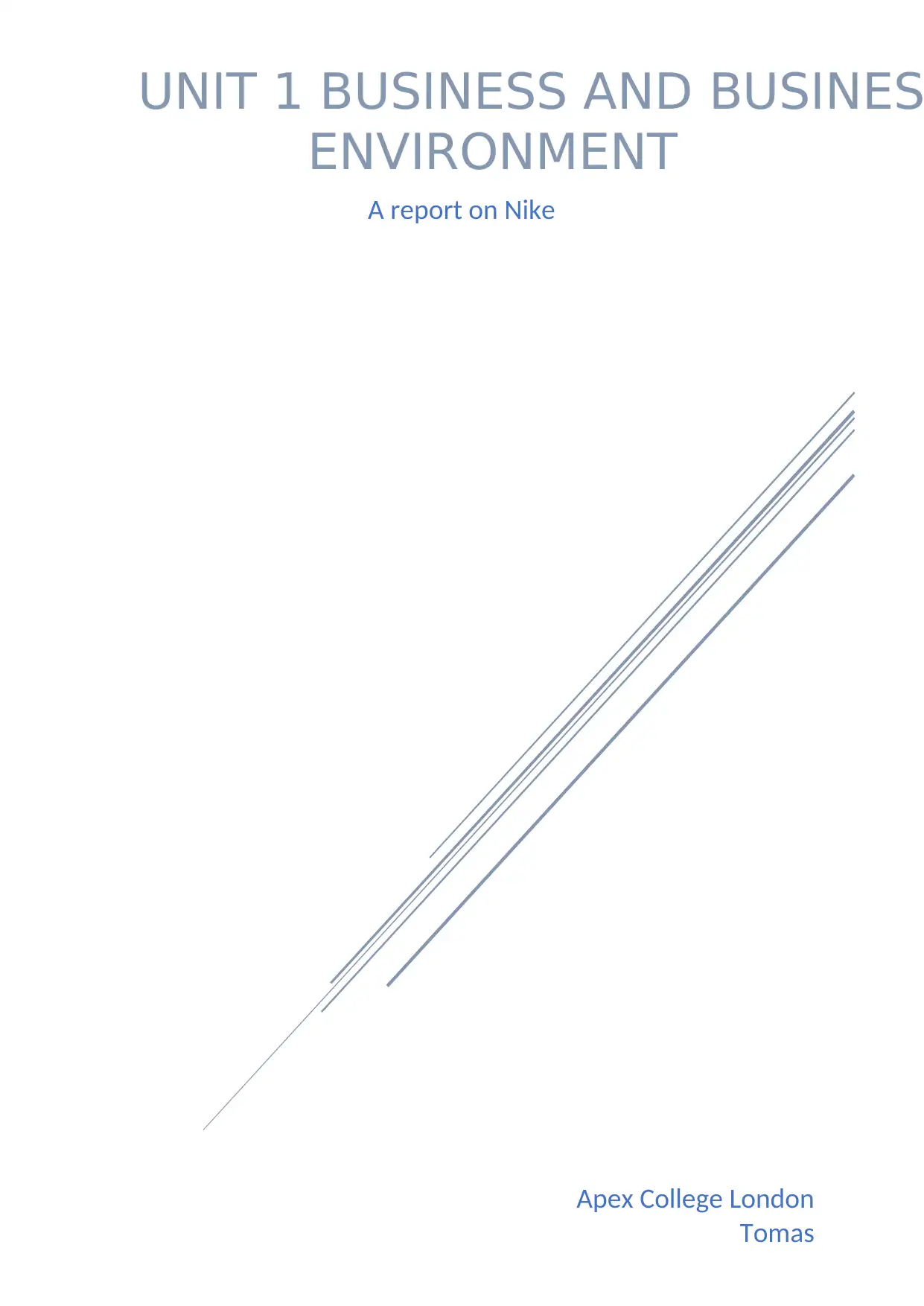
Apex College London
Tomas
UNIT 1 BUSINESS AND BUSINES
ENVIRONMENT
A report on Nike
Tomas
UNIT 1 BUSINESS AND BUSINES
ENVIRONMENT
A report on Nike
Secure Best Marks with AI Grader
Need help grading? Try our AI Grader for instant feedback on your assignments.
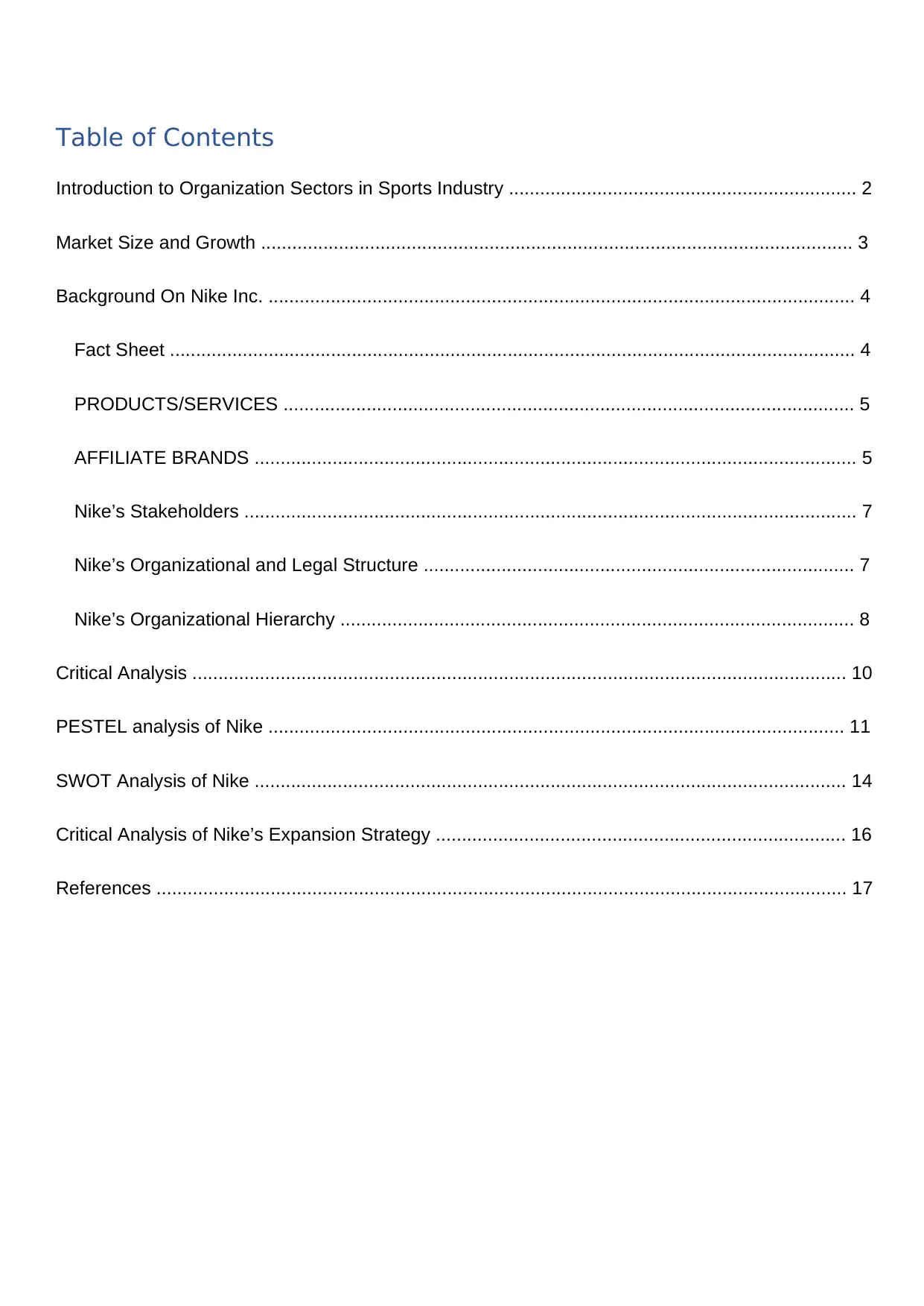
Table of Contents
Introduction to Organization Sectors in Sports Industry ................................................................... 2
Market Size and Growth .................................................................................................................. 3
Background On Nike Inc. ................................................................................................................. 4
Fact Sheet .................................................................................................................................... 4
PRODUCTS/SERVICES .............................................................................................................. 5
AFFILIATE BRANDS .................................................................................................................... 5
Nike’s Stakeholders ...................................................................................................................... 7
Nike’s Organizational and Legal Structure ................................................................................... 7
Nike’s Organizational Hierarchy ................................................................................................... 8
Critical Analysis .............................................................................................................................. 10
PESTEL analysis of Nike ............................................................................................................... 11
SWOT Analysis of Nike .................................................................................................................. 14
Critical Analysis of Nike’s Expansion Strategy ............................................................................... 16
References ..................................................................................................................................... 17
Introduction to Organization Sectors in Sports Industry ................................................................... 2
Market Size and Growth .................................................................................................................. 3
Background On Nike Inc. ................................................................................................................. 4
Fact Sheet .................................................................................................................................... 4
PRODUCTS/SERVICES .............................................................................................................. 5
AFFILIATE BRANDS .................................................................................................................... 5
Nike’s Stakeholders ...................................................................................................................... 7
Nike’s Organizational and Legal Structure ................................................................................... 7
Nike’s Organizational Hierarchy ................................................................................................... 8
Critical Analysis .............................................................................................................................. 10
PESTEL analysis of Nike ............................................................................................................... 11
SWOT Analysis of Nike .................................................................................................................. 14
Critical Analysis of Nike’s Expansion Strategy ............................................................................... 16
References ..................................................................................................................................... 17
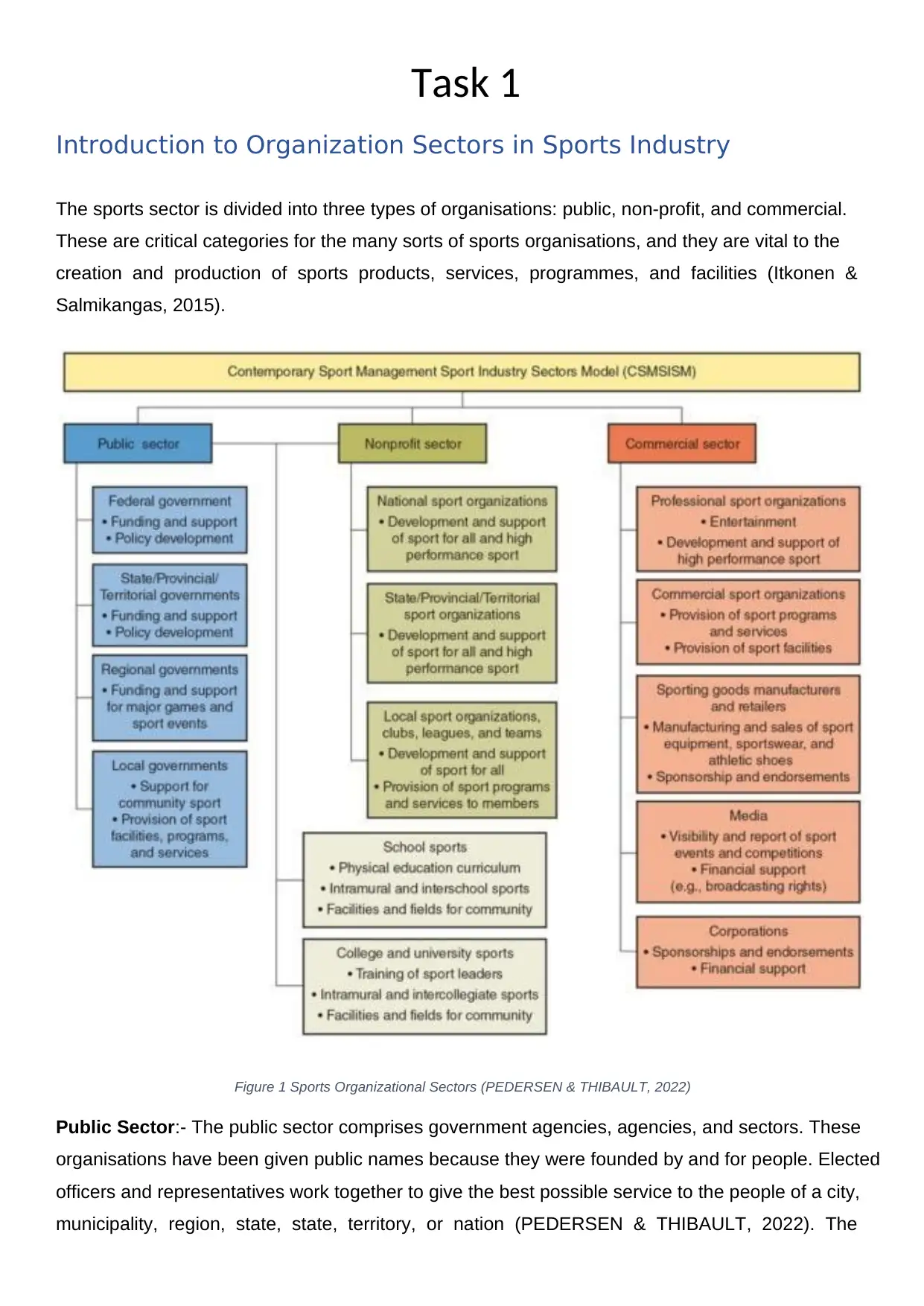
Task 1
Introduction to Organization Sectors in Sports Industry
The sports sector is divided into three types of organisations: public, non-profit, and commercial.
These are critical categories for the many sorts of sports organisations, and they are vital to the
creation and production of sports products, services, programmes, and facilities (Itkonen &
Salmikangas, 2015).
Figure 1 Sports Organizational Sectors (PEDERSEN & THIBAULT, 2022)
Public Sector:- The public sector comprises government agencies, agencies, and sectors. These
organisations have been given public names because they were founded by and for people. Elected
officers and representatives work together to give the best possible service to the people of a city,
municipality, region, state, state, territory, or nation (PEDERSEN & THIBAULT, 2022). The
Introduction to Organization Sectors in Sports Industry
The sports sector is divided into three types of organisations: public, non-profit, and commercial.
These are critical categories for the many sorts of sports organisations, and they are vital to the
creation and production of sports products, services, programmes, and facilities (Itkonen &
Salmikangas, 2015).
Figure 1 Sports Organizational Sectors (PEDERSEN & THIBAULT, 2022)
Public Sector:- The public sector comprises government agencies, agencies, and sectors. These
organisations have been given public names because they were founded by and for people. Elected
officers and representatives work together to give the best possible service to the people of a city,
municipality, region, state, state, territory, or nation (PEDERSEN & THIBAULT, 2022). The
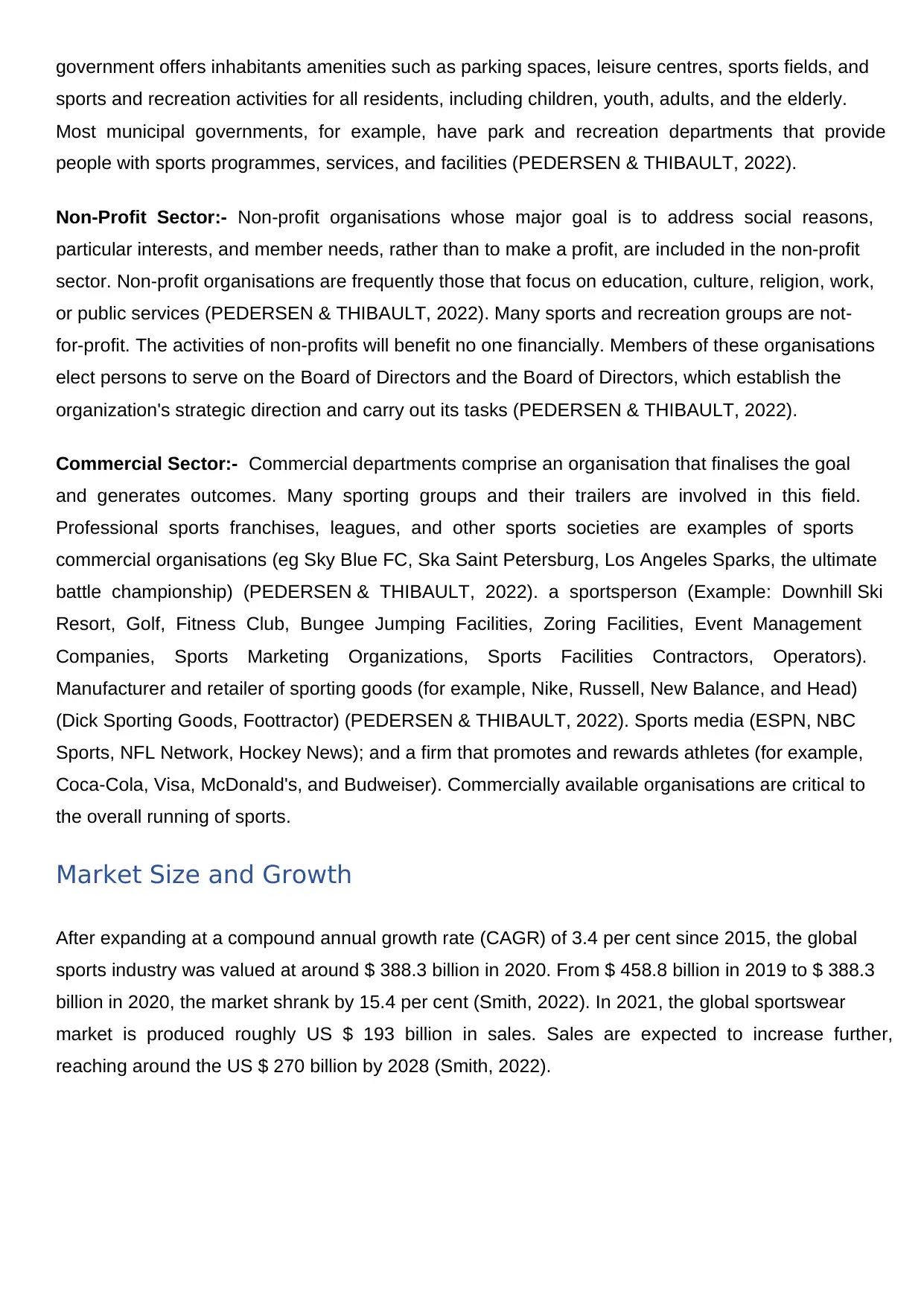
government offers inhabitants amenities such as parking spaces, leisure centres, sports fields, and
sports and recreation activities for all residents, including children, youth, adults, and the elderly.
Most municipal governments, for example, have park and recreation departments that provide
people with sports programmes, services, and facilities (PEDERSEN & THIBAULT, 2022).
Non-Profit Sector:- Non-profit organisations whose major goal is to address social reasons,
particular interests, and member needs, rather than to make a profit, are included in the non-profit
sector. Non-profit organisations are frequently those that focus on education, culture, religion, work,
or public services (PEDERSEN & THIBAULT, 2022). Many sports and recreation groups are not-
for-profit. The activities of non-profits will benefit no one financially. Members of these organisations
elect persons to serve on the Board of Directors and the Board of Directors, which establish the
organization's strategic direction and carry out its tasks (PEDERSEN & THIBAULT, 2022).
Commercial Sector:- Commercial departments comprise an organisation that finalises the goal
and generates outcomes. Many sporting groups and their trailers are involved in this field.
Professional sports franchises, leagues, and other sports societies are examples of sports
commercial organisations (eg Sky Blue FC, Ska Saint Petersburg, Los Angeles Sparks, the ultimate
battle championship) (PEDERSEN & THIBAULT, 2022). a sportsperson (Example: Downhill Ski
Resort, Golf, Fitness Club, Bungee Jumping Facilities, Zoring Facilities, Event Management
Companies, Sports Marketing Organizations, Sports Facilities Contractors, Operators).
Manufacturer and retailer of sporting goods (for example, Nike, Russell, New Balance, and Head)
(Dick Sporting Goods, Foottractor) (PEDERSEN & THIBAULT, 2022). Sports media (ESPN, NBC
Sports, NFL Network, Hockey News); and a firm that promotes and rewards athletes (for example,
Coca-Cola, Visa, McDonald's, and Budweiser). Commercially available organisations are critical to
the overall running of sports.
Market Size and Growth
After expanding at a compound annual growth rate (CAGR) of 3.4 per cent since 2015, the global
sports industry was valued at around $ 388.3 billion in 2020. From $ 458.8 billion in 2019 to $ 388.3
billion in 2020, the market shrank by 15.4 per cent (Smith, 2022). In 2021, the global sportswear
market is produced roughly US $ 193 billion in sales. Sales are expected to increase further,
reaching around the US $ 270 billion by 2028 (Smith, 2022).
sports and recreation activities for all residents, including children, youth, adults, and the elderly.
Most municipal governments, for example, have park and recreation departments that provide
people with sports programmes, services, and facilities (PEDERSEN & THIBAULT, 2022).
Non-Profit Sector:- Non-profit organisations whose major goal is to address social reasons,
particular interests, and member needs, rather than to make a profit, are included in the non-profit
sector. Non-profit organisations are frequently those that focus on education, culture, religion, work,
or public services (PEDERSEN & THIBAULT, 2022). Many sports and recreation groups are not-
for-profit. The activities of non-profits will benefit no one financially. Members of these organisations
elect persons to serve on the Board of Directors and the Board of Directors, which establish the
organization's strategic direction and carry out its tasks (PEDERSEN & THIBAULT, 2022).
Commercial Sector:- Commercial departments comprise an organisation that finalises the goal
and generates outcomes. Many sporting groups and their trailers are involved in this field.
Professional sports franchises, leagues, and other sports societies are examples of sports
commercial organisations (eg Sky Blue FC, Ska Saint Petersburg, Los Angeles Sparks, the ultimate
battle championship) (PEDERSEN & THIBAULT, 2022). a sportsperson (Example: Downhill Ski
Resort, Golf, Fitness Club, Bungee Jumping Facilities, Zoring Facilities, Event Management
Companies, Sports Marketing Organizations, Sports Facilities Contractors, Operators).
Manufacturer and retailer of sporting goods (for example, Nike, Russell, New Balance, and Head)
(Dick Sporting Goods, Foottractor) (PEDERSEN & THIBAULT, 2022). Sports media (ESPN, NBC
Sports, NFL Network, Hockey News); and a firm that promotes and rewards athletes (for example,
Coca-Cola, Visa, McDonald's, and Budweiser). Commercially available organisations are critical to
the overall running of sports.
Market Size and Growth
After expanding at a compound annual growth rate (CAGR) of 3.4 per cent since 2015, the global
sports industry was valued at around $ 388.3 billion in 2020. From $ 458.8 billion in 2019 to $ 388.3
billion in 2020, the market shrank by 15.4 per cent (Smith, 2022). In 2021, the global sportswear
market is produced roughly US $ 193 billion in sales. Sales are expected to increase further,
reaching around the US $ 270 billion by 2028 (Smith, 2022).
Secure Best Marks with AI Grader
Need help grading? Try our AI Grader for instant feedback on your assignments.
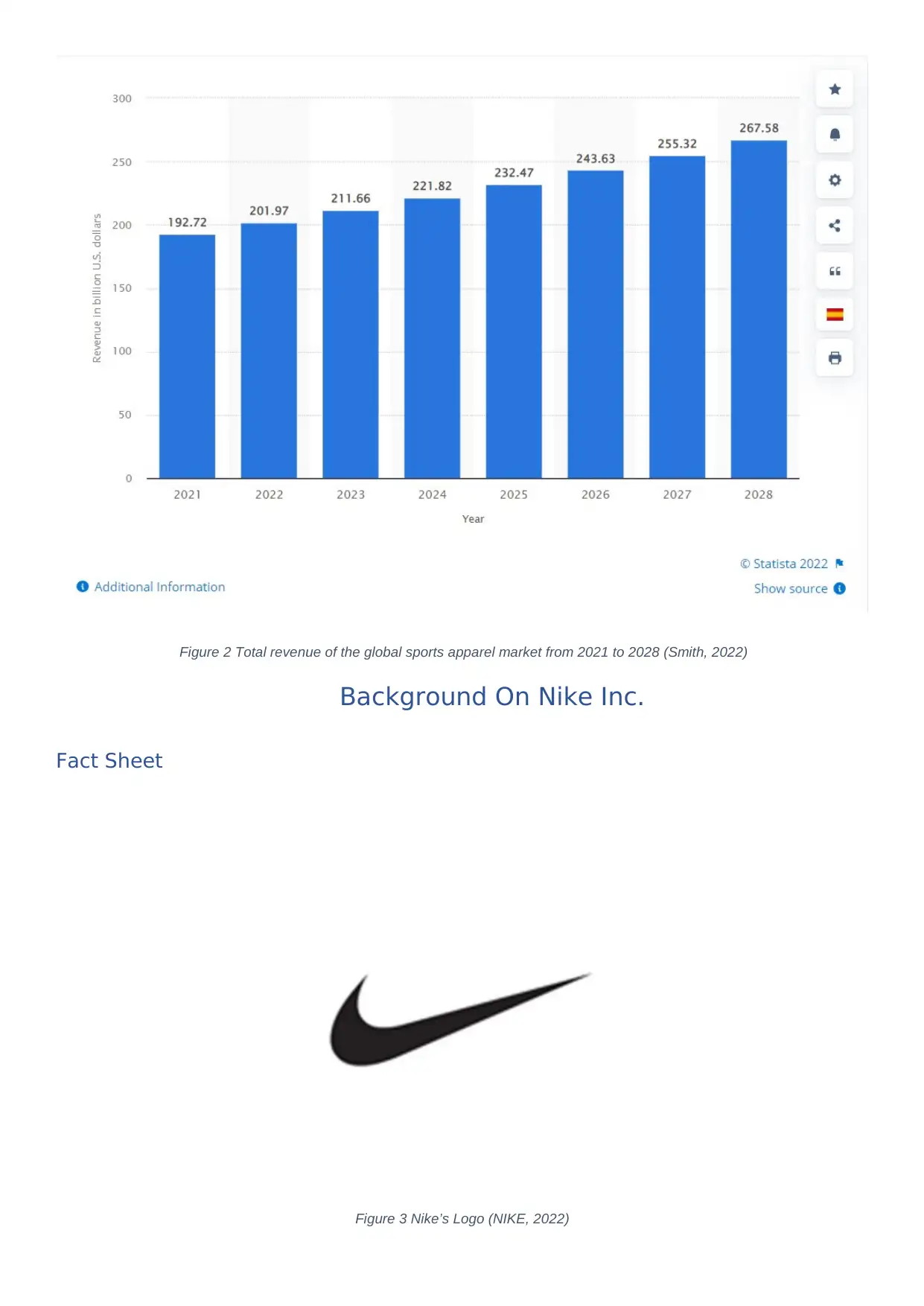
Figure 2 Total revenue of the global sports apparel market from 2021 to 2028 (Smith, 2022)
Background On Nike Inc.
Fact Sheet
Figure 3 Nike’s Logo (NIKE, 2022)
Background On Nike Inc.
Fact Sheet
Figure 3 Nike’s Logo (NIKE, 2022)
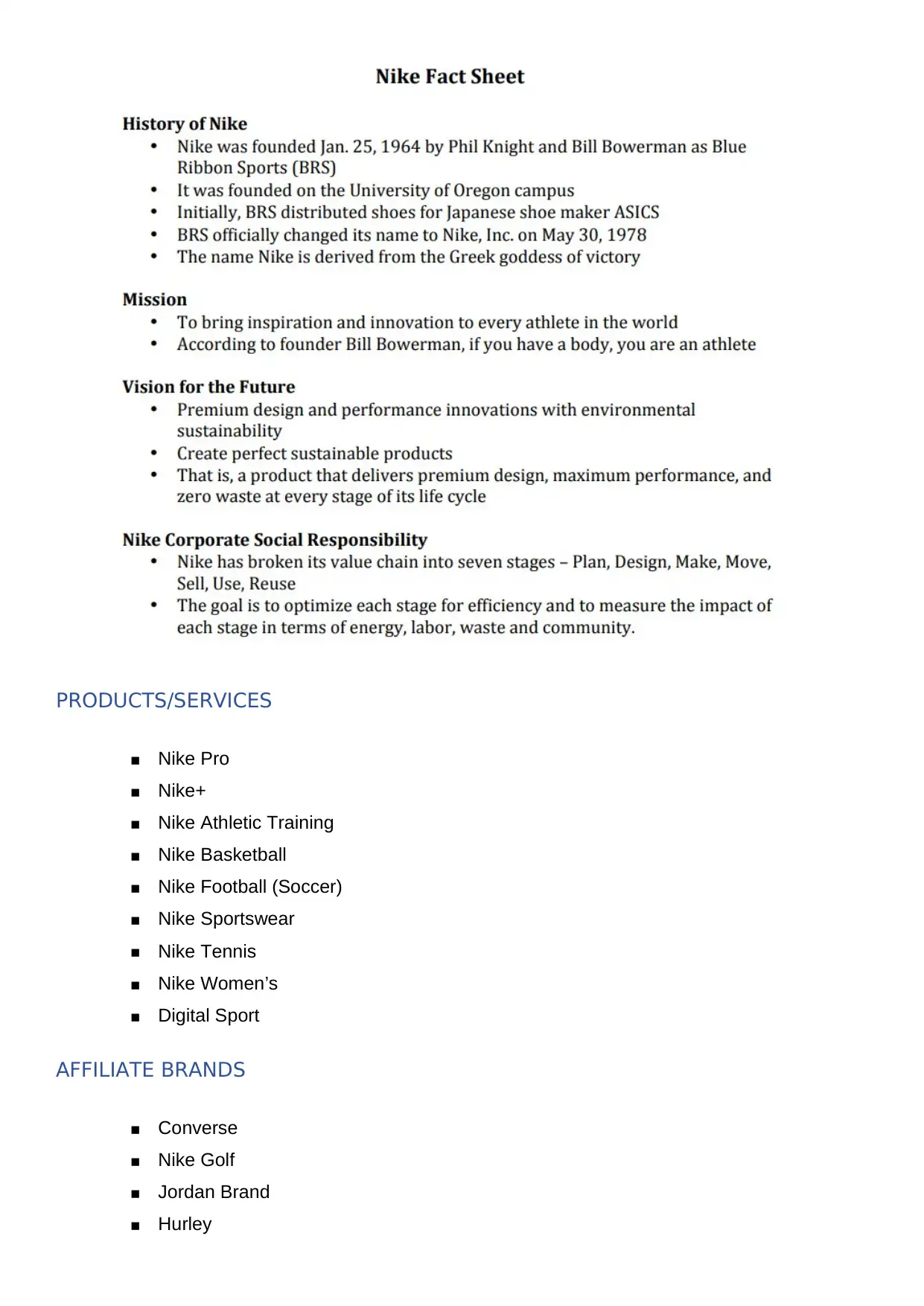
PRODUCTS/SERVICES
▪ Nike Pro
▪ Nike+
▪ Nike Athletic Training
▪ Nike Basketball
▪ Nike Football (Soccer)
▪ Nike Sportswear
▪ Nike Tennis
▪ Nike Women’s
▪ Digital Sport
AFFILIATE BRANDS
▪ Converse
▪ Nike Golf
▪ Jordan Brand
▪ Hurley
▪ Nike Pro
▪ Nike+
▪ Nike Athletic Training
▪ Nike Basketball
▪ Nike Football (Soccer)
▪ Nike Sportswear
▪ Nike Tennis
▪ Nike Women’s
▪ Digital Sport
AFFILIATE BRANDS
▪ Converse
▪ Nike Golf
▪ Jordan Brand
▪ Hurley
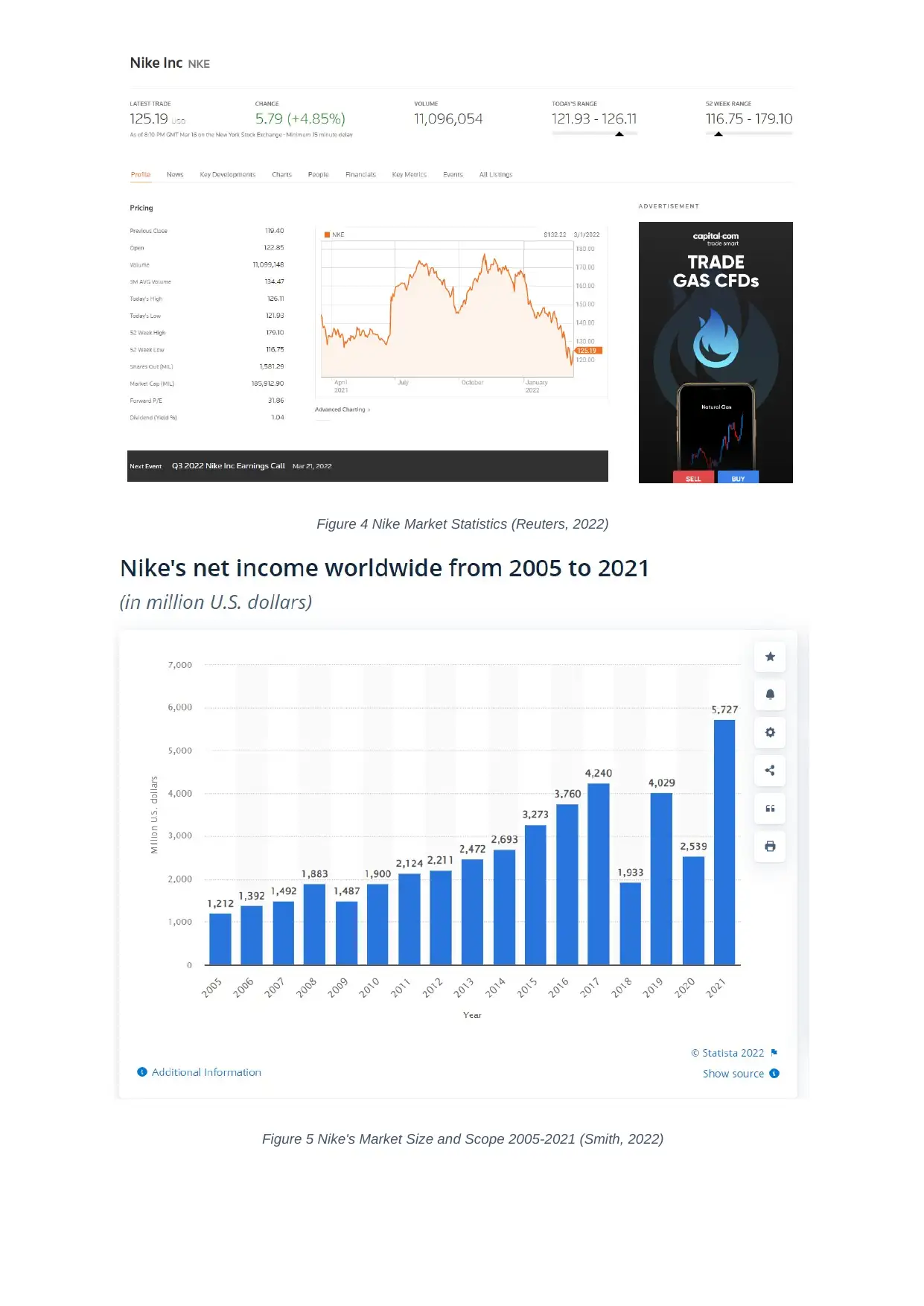
Figure 4 Nike Market Statistics (Reuters, 2022)
Figure 5 Nike's Market Size and Scope 2005-2021 (Smith, 2022)
Figure 5 Nike's Market Size and Scope 2005-2021 (Smith, 2022)
Paraphrase This Document
Need a fresh take? Get an instant paraphrase of this document with our AI Paraphraser
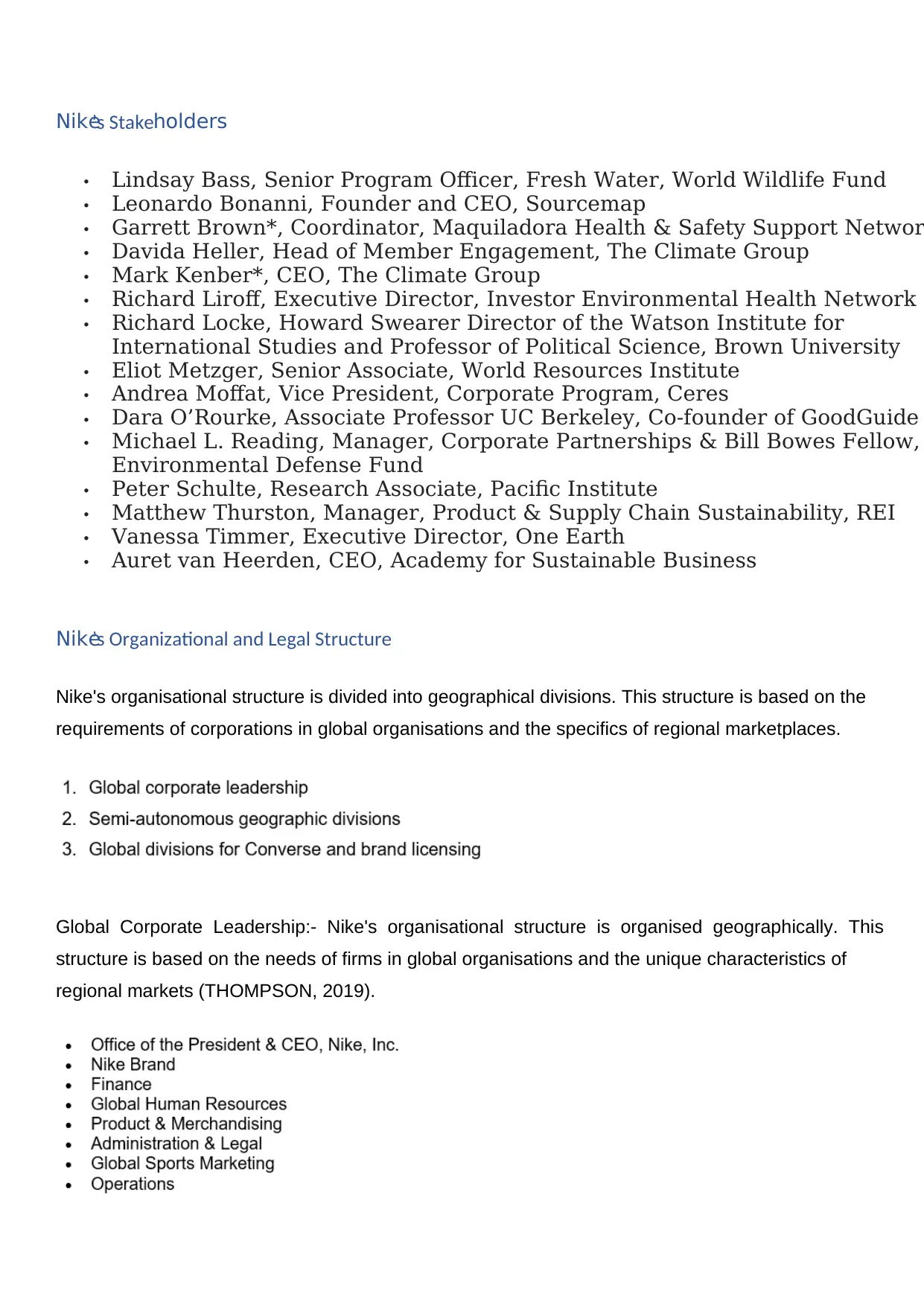
Nike’s Stakeholders
Nike’s Organizational and Legal Structure
Nike's organisational structure is divided into geographical divisions. This structure is based on the
requirements of corporations in global organisations and the specifics of regional marketplaces.
Global Corporate Leadership:- Nike's organisational structure is organised geographically. This
structure is based on the needs of firms in global organisations and the unique characteristics of
regional markets (THOMPSON, 2019).
• Lindsay Bass, Senior Program Officer, Fresh Water, World Wildlife Fund
• Leonardo Bonanni, Founder and CEO, Sourcemap
• Garrett Brown*, Coordinator, Maquiladora Health & Safety Support Networ
• Davida Heller, Head of Member Engagement, The Climate Group
• Mark Kenber*, CEO, The Climate Group
• Richard Liroff, Executive Director, Investor Environmental Health Network
• Richard Locke, Howard Swearer Director of the Watson Institute for
International Studies and Professor of Political Science, Brown University
• Eliot Metzger, Senior Associate, World Resources Institute
• Andrea Moffat, Vice President, Corporate Program, Ceres
• Dara O’Rourke, Associate Professor UC Berkeley, Co-founder of GoodGuide
• Michael L. Reading, Manager, Corporate Partnerships & Bill Bowes Fellow,
Environmental Defense Fund
• Peter Schulte, Research Associate, Pacific Institute
• Matthew Thurston, Manager, Product & Supply Chain Sustainability, REI
• Vanessa Timmer, Executive Director, One Earth
• Auret van Heerden, CEO, Academy for Sustainable Business
Nike’s Organizational and Legal Structure
Nike's organisational structure is divided into geographical divisions. This structure is based on the
requirements of corporations in global organisations and the specifics of regional marketplaces.
Global Corporate Leadership:- Nike's organisational structure is organised geographically. This
structure is based on the needs of firms in global organisations and the unique characteristics of
regional markets (THOMPSON, 2019).
• Lindsay Bass, Senior Program Officer, Fresh Water, World Wildlife Fund
• Leonardo Bonanni, Founder and CEO, Sourcemap
• Garrett Brown*, Coordinator, Maquiladora Health & Safety Support Networ
• Davida Heller, Head of Member Engagement, The Climate Group
• Mark Kenber*, CEO, The Climate Group
• Richard Liroff, Executive Director, Investor Environmental Health Network
• Richard Locke, Howard Swearer Director of the Watson Institute for
International Studies and Professor of Political Science, Brown University
• Eliot Metzger, Senior Associate, World Resources Institute
• Andrea Moffat, Vice President, Corporate Program, Ceres
• Dara O’Rourke, Associate Professor UC Berkeley, Co-founder of GoodGuide
• Michael L. Reading, Manager, Corporate Partnerships & Bill Bowes Fellow,
Environmental Defense Fund
• Peter Schulte, Research Associate, Pacific Institute
• Matthew Thurston, Manager, Product & Supply Chain Sustainability, REI
• Vanessa Timmer, Executive Director, One Earth
• Auret van Heerden, CEO, Academy for Sustainable Business
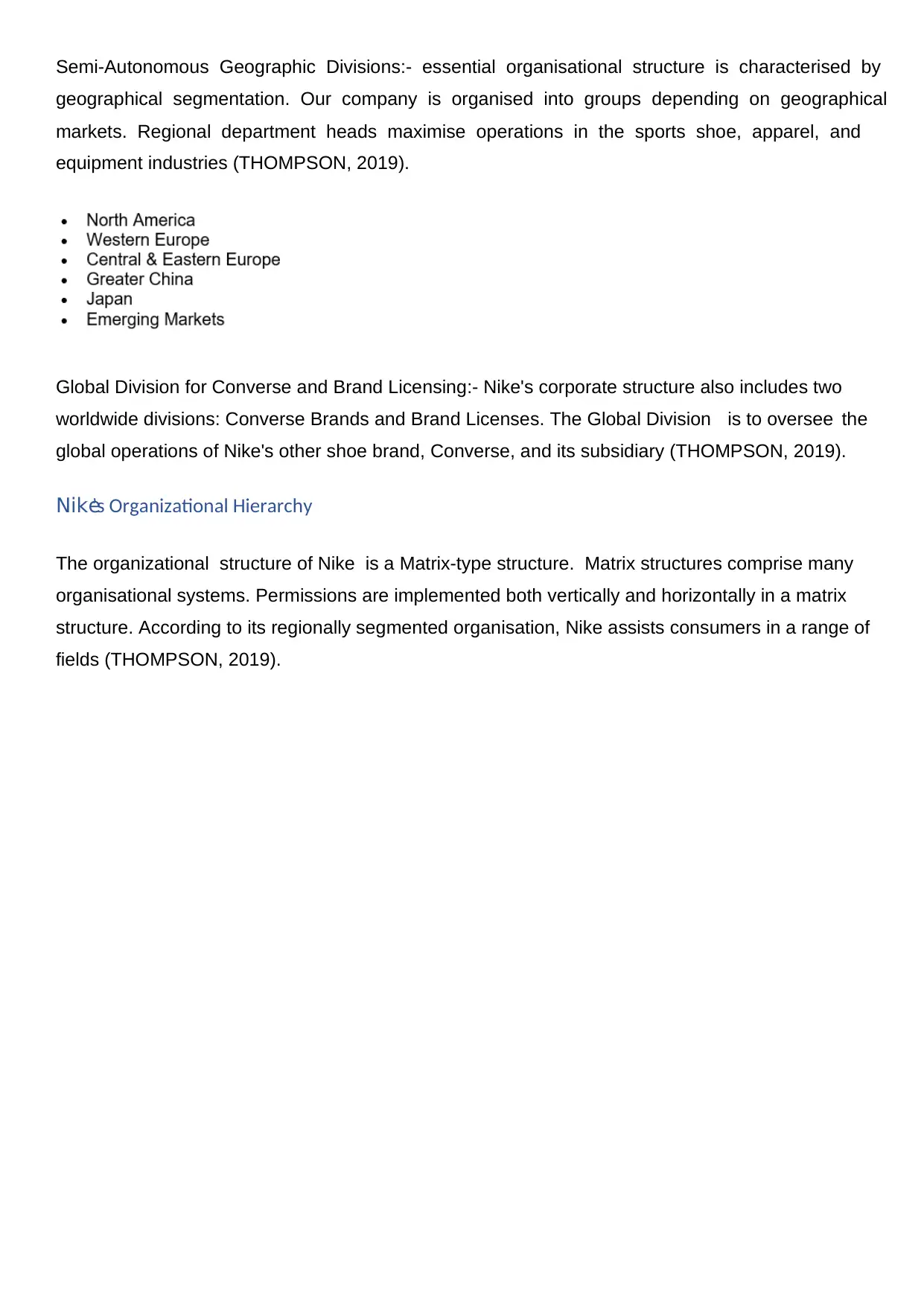
Semi-Autonomous Geographic Divisions:- essential organisational structure is characterised by
geographical segmentation. Our company is organised into groups depending on geographical
markets. Regional department heads maximise operations in the sports shoe, apparel, and
equipment industries (THOMPSON, 2019).
Global Division for Converse and Brand Licensing:- Nike's corporate structure also includes two
worldwide divisions: Converse Brands and Brand Licenses. The Global Division is to oversee the
global operations of Nike's other shoe brand, Converse, and its subsidiary (THOMPSON, 2019).
Nike’s Organizational Hierarchy
The organizational structure of Nike is a Matrix-type structure. Matrix structures comprise many
organisational systems. Permissions are implemented both vertically and horizontally in a matrix
structure. According to its regionally segmented organisation, Nike assists consumers in a range of
fields (THOMPSON, 2019).
geographical segmentation. Our company is organised into groups depending on geographical
markets. Regional department heads maximise operations in the sports shoe, apparel, and
equipment industries (THOMPSON, 2019).
Global Division for Converse and Brand Licensing:- Nike's corporate structure also includes two
worldwide divisions: Converse Brands and Brand Licenses. The Global Division is to oversee the
global operations of Nike's other shoe brand, Converse, and its subsidiary (THOMPSON, 2019).
Nike’s Organizational Hierarchy
The organizational structure of Nike is a Matrix-type structure. Matrix structures comprise many
organisational systems. Permissions are implemented both vertically and horizontally in a matrix
structure. According to its regionally segmented organisation, Nike assists consumers in a range of
fields (THOMPSON, 2019).
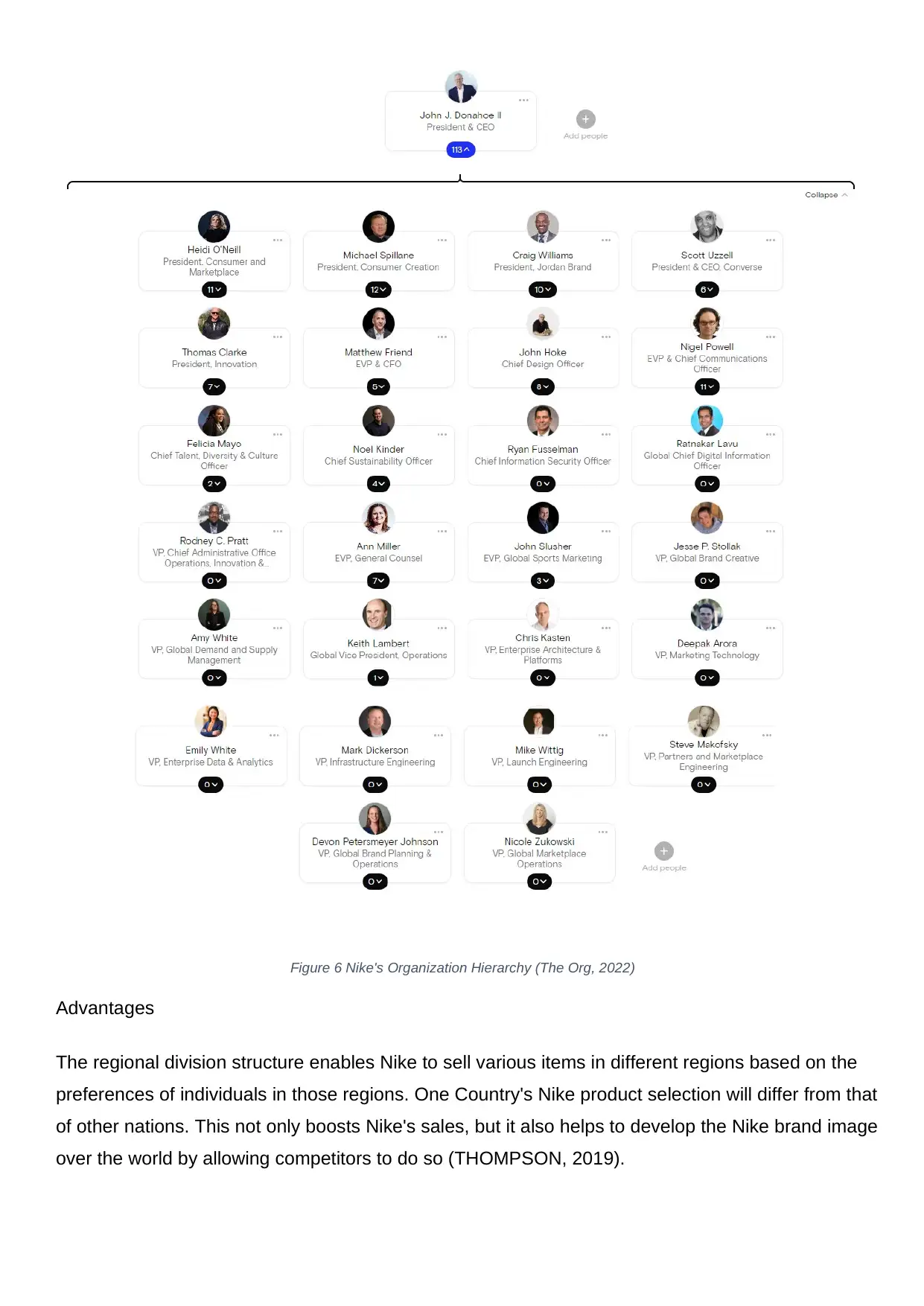
Figure 6 Nike's Organization Hierarchy (The Org, 2022)
Advantages
The regional division structure enables Nike to sell various items in different regions based on the
preferences of individuals in those regions. One Country's Nike product selection will differ from that
of other nations. This not only boosts Nike's sales, but it also helps to develop the Nike brand image
over the world by allowing competitors to do so (THOMPSON, 2019).
Advantages
The regional division structure enables Nike to sell various items in different regions based on the
preferences of individuals in those regions. One Country's Nike product selection will differ from that
of other nations. This not only boosts Nike's sales, but it also helps to develop the Nike brand image
over the world by allowing competitors to do so (THOMPSON, 2019).
Secure Best Marks with AI Grader
Need help grading? Try our AI Grader for instant feedback on your assignments.
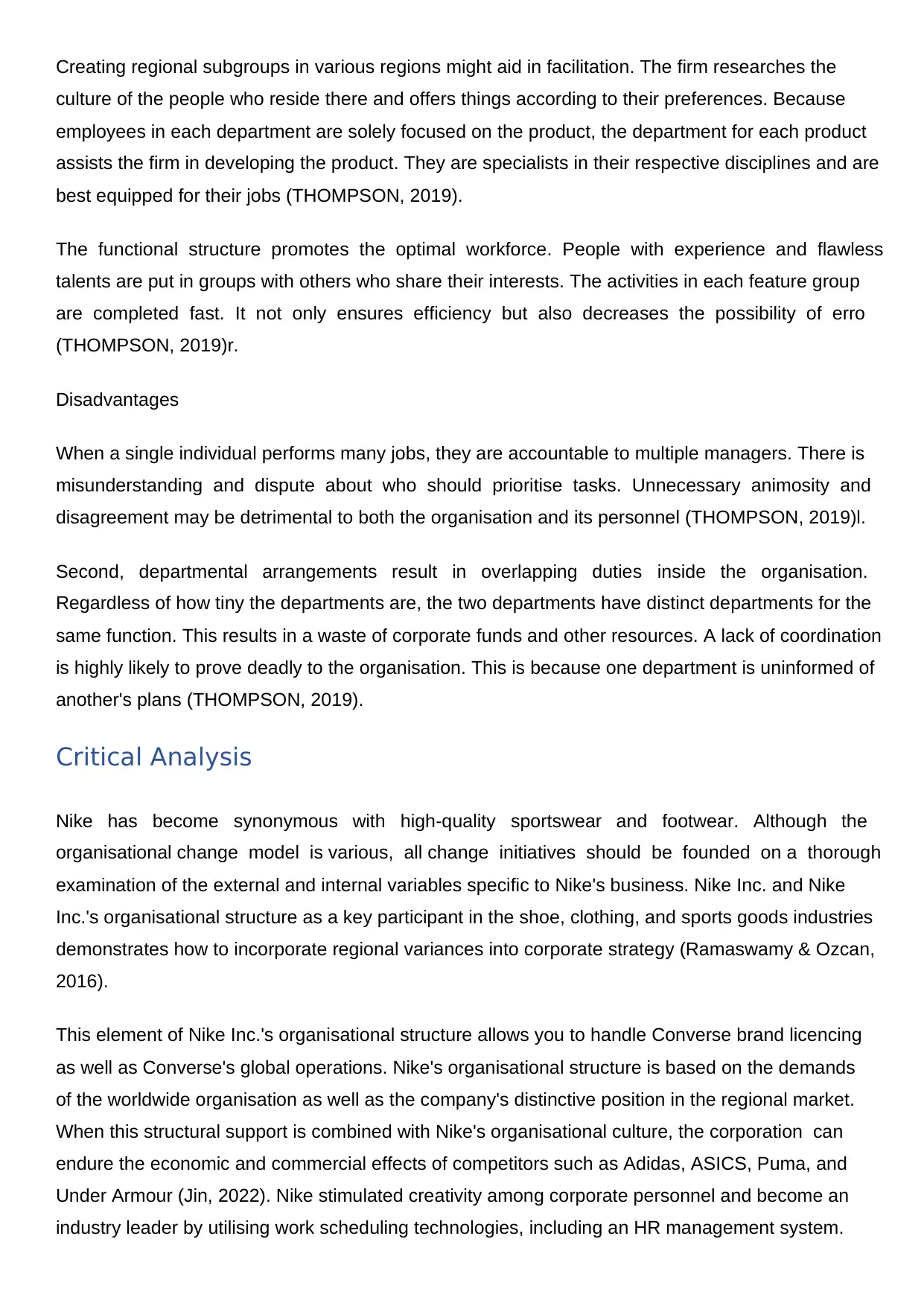
Creating regional subgroups in various regions might aid in facilitation. The firm researches the
culture of the people who reside there and offers things according to their preferences. Because
employees in each department are solely focused on the product, the department for each product
assists the firm in developing the product. They are specialists in their respective disciplines and are
best equipped for their jobs (THOMPSON, 2019).
The functional structure promotes the optimal workforce. People with experience and flawless
talents are put in groups with others who share their interests. The activities in each feature group
are completed fast. It not only ensures efficiency but also decreases the possibility of erro
(THOMPSON, 2019)r.
Disadvantages
When a single individual performs many jobs, they are accountable to multiple managers. There is
misunderstanding and dispute about who should prioritise tasks. Unnecessary animosity and
disagreement may be detrimental to both the organisation and its personnel (THOMPSON, 2019)l.
Second, departmental arrangements result in overlapping duties inside the organisation.
Regardless of how tiny the departments are, the two departments have distinct departments for the
same function. This results in a waste of corporate funds and other resources. A lack of coordination
is highly likely to prove deadly to the organisation. This is because one department is uninformed of
another's plans (THOMPSON, 2019).
Critical Analysis
Nike has become synonymous with high-quality sportswear and footwear. Although the
organisational change model is various, all change initiatives should be founded on a thorough
examination of the external and internal variables specific to Nike's business. Nike Inc. and Nike
Inc.'s organisational structure as a key participant in the shoe, clothing, and sports goods industries
demonstrates how to incorporate regional variances into corporate strategy (Ramaswamy & Ozcan,
2016).
This element of Nike Inc.'s organisational structure allows you to handle Converse brand licencing
as well as Converse's global operations. Nike's organisational structure is based on the demands
of the worldwide organisation as well as the company's distinctive position in the regional market.
When this structural support is combined with Nike's organisational culture, the corporation can
endure the economic and commercial effects of competitors such as Adidas, ASICS, Puma, and
Under Armour (Jin, 2022). Nike stimulated creativity among corporate personnel and become an
industry leader by utilising work scheduling technologies, including an HR management system.
culture of the people who reside there and offers things according to their preferences. Because
employees in each department are solely focused on the product, the department for each product
assists the firm in developing the product. They are specialists in their respective disciplines and are
best equipped for their jobs (THOMPSON, 2019).
The functional structure promotes the optimal workforce. People with experience and flawless
talents are put in groups with others who share their interests. The activities in each feature group
are completed fast. It not only ensures efficiency but also decreases the possibility of erro
(THOMPSON, 2019)r.
Disadvantages
When a single individual performs many jobs, they are accountable to multiple managers. There is
misunderstanding and dispute about who should prioritise tasks. Unnecessary animosity and
disagreement may be detrimental to both the organisation and its personnel (THOMPSON, 2019)l.
Second, departmental arrangements result in overlapping duties inside the organisation.
Regardless of how tiny the departments are, the two departments have distinct departments for the
same function. This results in a waste of corporate funds and other resources. A lack of coordination
is highly likely to prove deadly to the organisation. This is because one department is uninformed of
another's plans (THOMPSON, 2019).
Critical Analysis
Nike has become synonymous with high-quality sportswear and footwear. Although the
organisational change model is various, all change initiatives should be founded on a thorough
examination of the external and internal variables specific to Nike's business. Nike Inc. and Nike
Inc.'s organisational structure as a key participant in the shoe, clothing, and sports goods industries
demonstrates how to incorporate regional variances into corporate strategy (Ramaswamy & Ozcan,
2016).
This element of Nike Inc.'s organisational structure allows you to handle Converse brand licencing
as well as Converse's global operations. Nike's organisational structure is based on the demands
of the worldwide organisation as well as the company's distinctive position in the regional market.
When this structural support is combined with Nike's organisational culture, the corporation can
endure the economic and commercial effects of competitors such as Adidas, ASICS, Puma, and
Under Armour (Jin, 2022). Nike stimulated creativity among corporate personnel and become an
industry leader by utilising work scheduling technologies, including an HR management system.
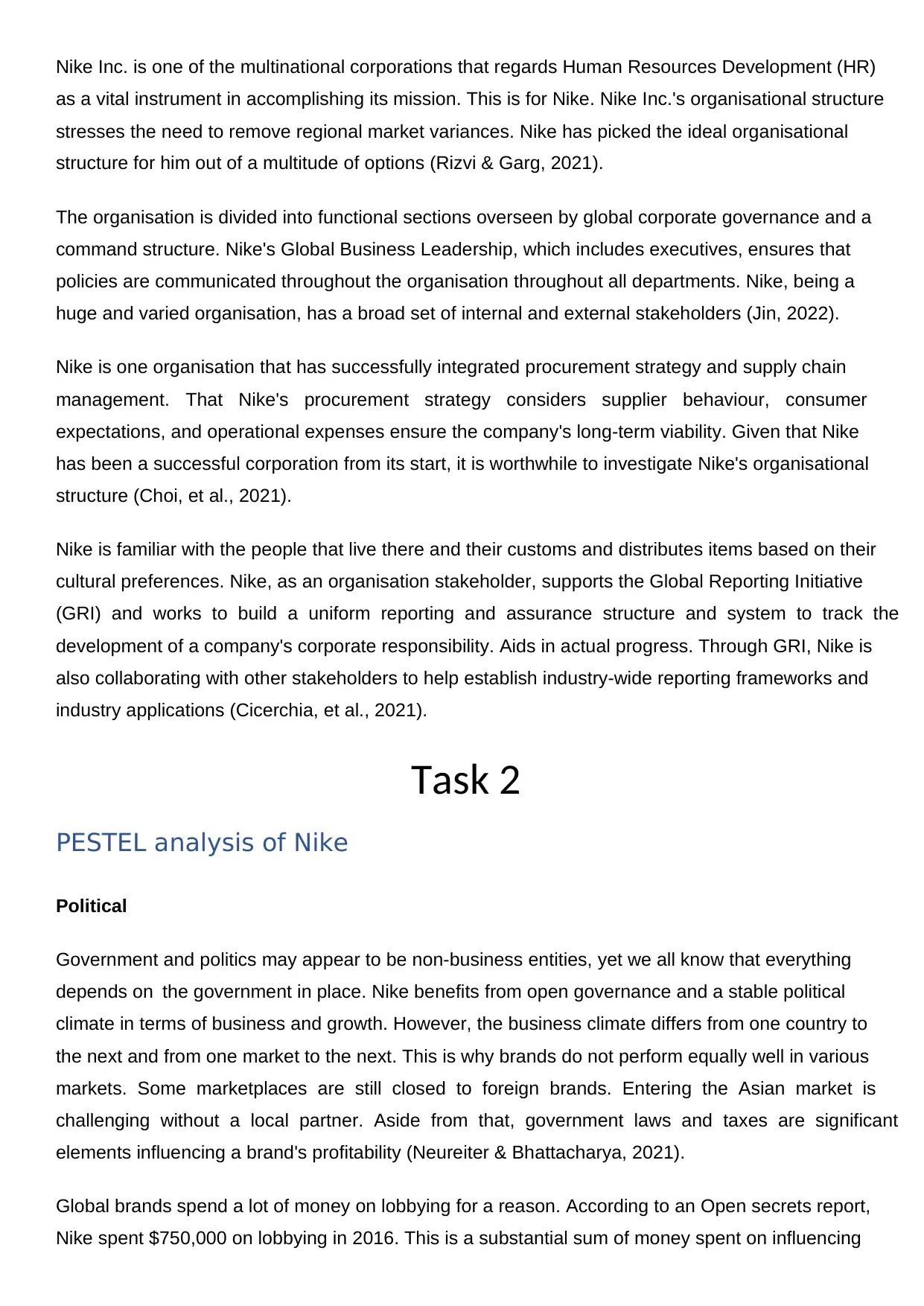
Nike Inc. is one of the multinational corporations that regards Human Resources Development (HR)
as a vital instrument in accomplishing its mission. This is for Nike. Nike Inc.'s organisational structure
stresses the need to remove regional market variances. Nike has picked the ideal organisational
structure for him out of a multitude of options (Rizvi & Garg, 2021).
The organisation is divided into functional sections overseen by global corporate governance and a
command structure. Nike's Global Business Leadership, which includes executives, ensures that
policies are communicated throughout the organisation throughout all departments. Nike, being a
huge and varied organisation, has a broad set of internal and external stakeholders (Jin, 2022).
Nike is one organisation that has successfully integrated procurement strategy and supply chain
management. That Nike's procurement strategy considers supplier behaviour, consumer
expectations, and operational expenses ensure the company's long-term viability. Given that Nike
has been a successful corporation from its start, it is worthwhile to investigate Nike's organisational
structure (Choi, et al., 2021).
Nike is familiar with the people that live there and their customs and distributes items based on their
cultural preferences. Nike, as an organisation stakeholder, supports the Global Reporting Initiative
(GRI) and works to build a uniform reporting and assurance structure and system to track the
development of a company's corporate responsibility. Aids in actual progress. Through GRI, Nike is
also collaborating with other stakeholders to help establish industry-wide reporting frameworks and
industry applications (Cicerchia, et al., 2021).
Task 2
PESTEL analysis of Nike
Political
Government and politics may appear to be non-business entities, yet we all know that everything
depends on the government in place. Nike benefits from open governance and a stable political
climate in terms of business and growth. However, the business climate differs from one country to
the next and from one market to the next. This is why brands do not perform equally well in various
markets. Some marketplaces are still closed to foreign brands. Entering the Asian market is
challenging without a local partner. Aside from that, government laws and taxes are significant
elements influencing a brand's profitability (Neureiter & Bhattacharya, 2021).
Global brands spend a lot of money on lobbying for a reason. According to an Open secrets report,
Nike spent $750,000 on lobbying in 2016. This is a substantial sum of money spent on influencing
as a vital instrument in accomplishing its mission. This is for Nike. Nike Inc.'s organisational structure
stresses the need to remove regional market variances. Nike has picked the ideal organisational
structure for him out of a multitude of options (Rizvi & Garg, 2021).
The organisation is divided into functional sections overseen by global corporate governance and a
command structure. Nike's Global Business Leadership, which includes executives, ensures that
policies are communicated throughout the organisation throughout all departments. Nike, being a
huge and varied organisation, has a broad set of internal and external stakeholders (Jin, 2022).
Nike is one organisation that has successfully integrated procurement strategy and supply chain
management. That Nike's procurement strategy considers supplier behaviour, consumer
expectations, and operational expenses ensure the company's long-term viability. Given that Nike
has been a successful corporation from its start, it is worthwhile to investigate Nike's organisational
structure (Choi, et al., 2021).
Nike is familiar with the people that live there and their customs and distributes items based on their
cultural preferences. Nike, as an organisation stakeholder, supports the Global Reporting Initiative
(GRI) and works to build a uniform reporting and assurance structure and system to track the
development of a company's corporate responsibility. Aids in actual progress. Through GRI, Nike is
also collaborating with other stakeholders to help establish industry-wide reporting frameworks and
industry applications (Cicerchia, et al., 2021).
Task 2
PESTEL analysis of Nike
Political
Government and politics may appear to be non-business entities, yet we all know that everything
depends on the government in place. Nike benefits from open governance and a stable political
climate in terms of business and growth. However, the business climate differs from one country to
the next and from one market to the next. This is why brands do not perform equally well in various
markets. Some marketplaces are still closed to foreign brands. Entering the Asian market is
challenging without a local partner. Aside from that, government laws and taxes are significant
elements influencing a brand's profitability (Neureiter & Bhattacharya, 2021).
Global brands spend a lot of money on lobbying for a reason. According to an Open secrets report,
Nike spent $750,000 on lobbying in 2016. This is a substantial sum of money spent on influencing
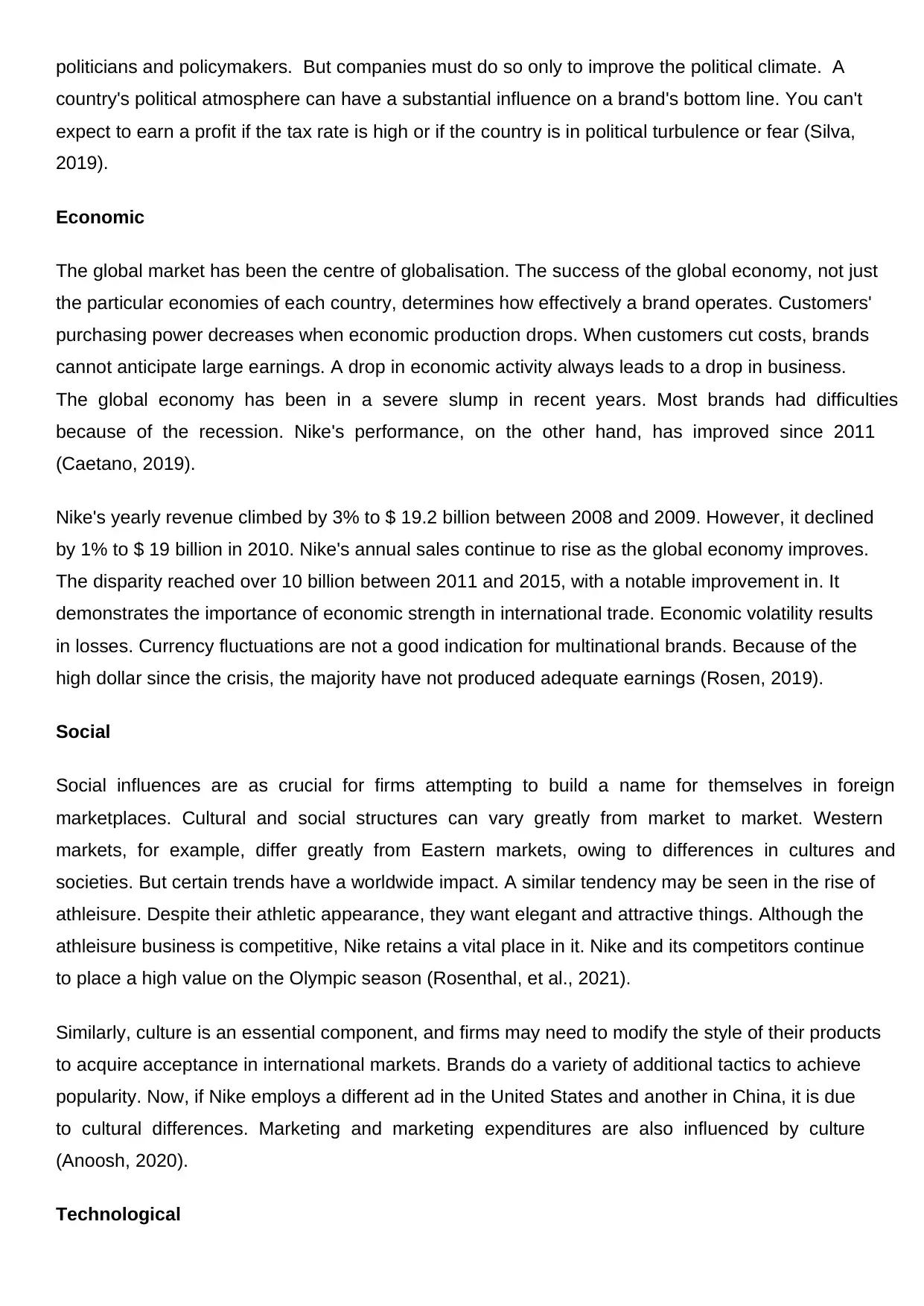
politicians and policymakers. But companies must do so only to improve the political climate. A
country's political atmosphere can have a substantial influence on a brand's bottom line. You can't
expect to earn a profit if the tax rate is high or if the country is in political turbulence or fear (Silva,
2019).
Economic
The global market has been the centre of globalisation. The success of the global economy, not just
the particular economies of each country, determines how effectively a brand operates. Customers'
purchasing power decreases when economic production drops. When customers cut costs, brands
cannot anticipate large earnings. A drop in economic activity always leads to a drop in business.
The global economy has been in a severe slump in recent years. Most brands had difficulties
because of the recession. Nike's performance, on the other hand, has improved since 2011
(Caetano, 2019).
Nike's yearly revenue climbed by 3% to $ 19.2 billion between 2008 and 2009. However, it declined
by 1% to $ 19 billion in 2010. Nike's annual sales continue to rise as the global economy improves.
The disparity reached over 10 billion between 2011 and 2015, with a notable improvement in. It
demonstrates the importance of economic strength in international trade. Economic volatility results
in losses. Currency fluctuations are not a good indication for multinational brands. Because of the
high dollar since the crisis, the majority have not produced adequate earnings (Rosen, 2019).
Social
Social influences are as crucial for firms attempting to build a name for themselves in foreign
marketplaces. Cultural and social structures can vary greatly from market to market. Western
markets, for example, differ greatly from Eastern markets, owing to differences in cultures and
societies. But certain trends have a worldwide impact. A similar tendency may be seen in the rise of
athleisure. Despite their athletic appearance, they want elegant and attractive things. Although the
athleisure business is competitive, Nike retains a vital place in it. Nike and its competitors continue
to place a high value on the Olympic season (Rosenthal, et al., 2021).
Similarly, culture is an essential component, and firms may need to modify the style of their products
to acquire acceptance in international markets. Brands do a variety of additional tactics to achieve
popularity. Now, if Nike employs a different ad in the United States and another in China, it is due
to cultural differences. Marketing and marketing expenditures are also influenced by culture
(Anoosh, 2020).
Technological
country's political atmosphere can have a substantial influence on a brand's bottom line. You can't
expect to earn a profit if the tax rate is high or if the country is in political turbulence or fear (Silva,
2019).
Economic
The global market has been the centre of globalisation. The success of the global economy, not just
the particular economies of each country, determines how effectively a brand operates. Customers'
purchasing power decreases when economic production drops. When customers cut costs, brands
cannot anticipate large earnings. A drop in economic activity always leads to a drop in business.
The global economy has been in a severe slump in recent years. Most brands had difficulties
because of the recession. Nike's performance, on the other hand, has improved since 2011
(Caetano, 2019).
Nike's yearly revenue climbed by 3% to $ 19.2 billion between 2008 and 2009. However, it declined
by 1% to $ 19 billion in 2010. Nike's annual sales continue to rise as the global economy improves.
The disparity reached over 10 billion between 2011 and 2015, with a notable improvement in. It
demonstrates the importance of economic strength in international trade. Economic volatility results
in losses. Currency fluctuations are not a good indication for multinational brands. Because of the
high dollar since the crisis, the majority have not produced adequate earnings (Rosen, 2019).
Social
Social influences are as crucial for firms attempting to build a name for themselves in foreign
marketplaces. Cultural and social structures can vary greatly from market to market. Western
markets, for example, differ greatly from Eastern markets, owing to differences in cultures and
societies. But certain trends have a worldwide impact. A similar tendency may be seen in the rise of
athleisure. Despite their athletic appearance, they want elegant and attractive things. Although the
athleisure business is competitive, Nike retains a vital place in it. Nike and its competitors continue
to place a high value on the Olympic season (Rosenthal, et al., 2021).
Similarly, culture is an essential component, and firms may need to modify the style of their products
to acquire acceptance in international markets. Brands do a variety of additional tactics to achieve
popularity. Now, if Nike employs a different ad in the United States and another in China, it is due
to cultural differences. Marketing and marketing expenditures are also influenced by culture
(Anoosh, 2020).
Technological
Paraphrase This Document
Need a fresh take? Get an instant paraphrase of this document with our AI Paraphraser
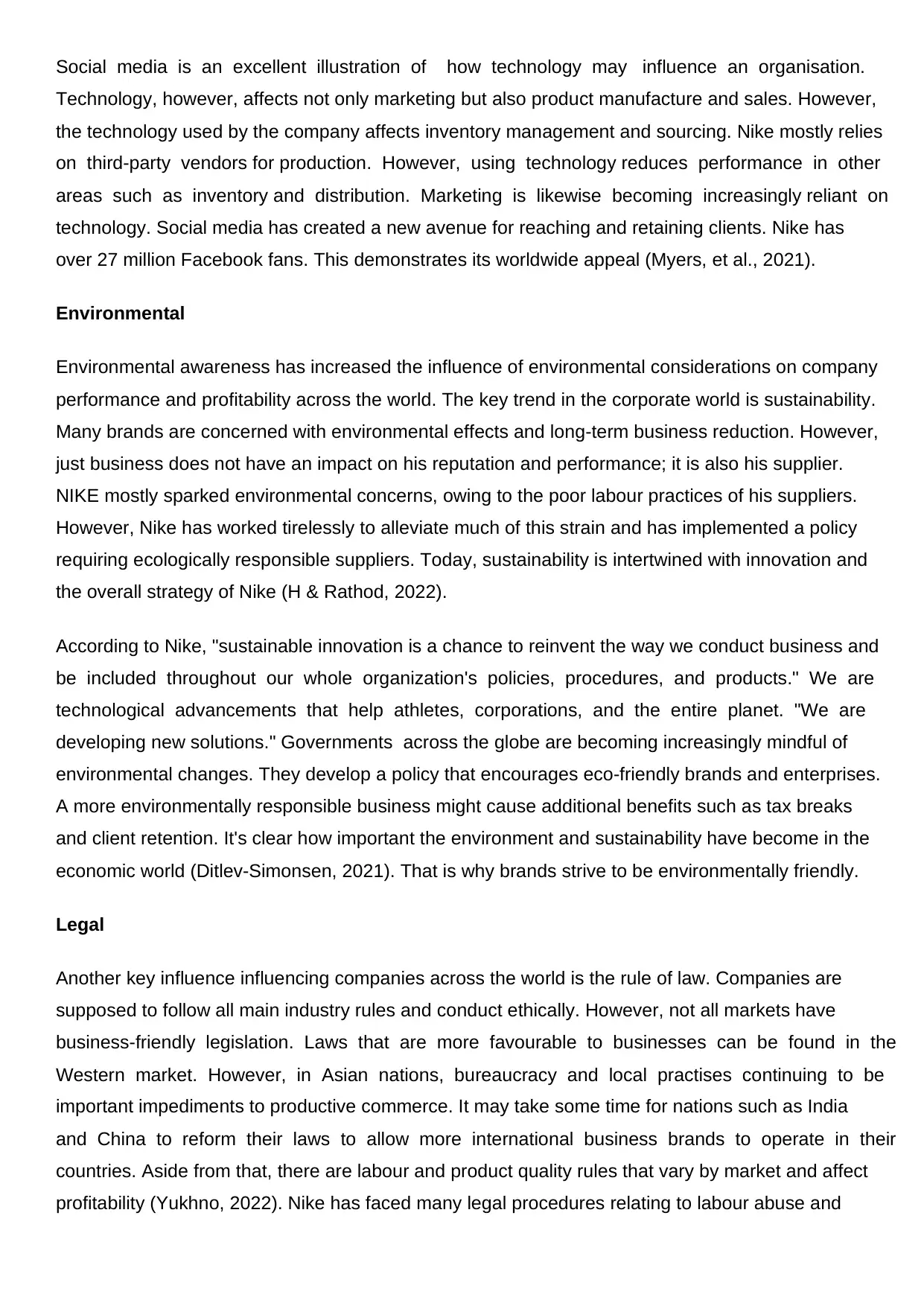
Social media is an excellent illustration of how technology may influence an organisation.
Technology, however, affects not only marketing but also product manufacture and sales. However,
the technology used by the company affects inventory management and sourcing. Nike mostly relies
on third-party vendors for production. However, using technology reduces performance in other
areas such as inventory and distribution. Marketing is likewise becoming increasingly reliant on
technology. Social media has created a new avenue for reaching and retaining clients. Nike has
over 27 million Facebook fans. This demonstrates its worldwide appeal (Myers, et al., 2021).
Environmental
Environmental awareness has increased the influence of environmental considerations on company
performance and profitability across the world. The key trend in the corporate world is sustainability.
Many brands are concerned with environmental effects and long-term business reduction. However,
just business does not have an impact on his reputation and performance; it is also his supplier.
NIKE mostly sparked environmental concerns, owing to the poor labour practices of his suppliers.
However, Nike has worked tirelessly to alleviate much of this strain and has implemented a policy
requiring ecologically responsible suppliers. Today, sustainability is intertwined with innovation and
the overall strategy of Nike (H & Rathod, 2022).
According to Nike, "sustainable innovation is a chance to reinvent the way we conduct business and
be included throughout our whole organization's policies, procedures, and products." We are
technological advancements that help athletes, corporations, and the entire planet. "We are
developing new solutions." Governments across the globe are becoming increasingly mindful of
environmental changes. They develop a policy that encourages eco-friendly brands and enterprises.
A more environmentally responsible business might cause additional benefits such as tax breaks
and client retention. It's clear how important the environment and sustainability have become in the
economic world (Ditlev-Simonsen, 2021). That is why brands strive to be environmentally friendly.
Legal
Another key influence influencing companies across the world is the rule of law. Companies are
supposed to follow all main industry rules and conduct ethically. However, not all markets have
business-friendly legislation. Laws that are more favourable to businesses can be found in the
Western market. However, in Asian nations, bureaucracy and local practises continuing to be
important impediments to productive commerce. It may take some time for nations such as India
and China to reform their laws to allow more international business brands to operate in their
countries. Aside from that, there are labour and product quality rules that vary by market and affect
profitability (Yukhno, 2022). Nike has faced many legal procedures relating to labour abuse and
Technology, however, affects not only marketing but also product manufacture and sales. However,
the technology used by the company affects inventory management and sourcing. Nike mostly relies
on third-party vendors for production. However, using technology reduces performance in other
areas such as inventory and distribution. Marketing is likewise becoming increasingly reliant on
technology. Social media has created a new avenue for reaching and retaining clients. Nike has
over 27 million Facebook fans. This demonstrates its worldwide appeal (Myers, et al., 2021).
Environmental
Environmental awareness has increased the influence of environmental considerations on company
performance and profitability across the world. The key trend in the corporate world is sustainability.
Many brands are concerned with environmental effects and long-term business reduction. However,
just business does not have an impact on his reputation and performance; it is also his supplier.
NIKE mostly sparked environmental concerns, owing to the poor labour practices of his suppliers.
However, Nike has worked tirelessly to alleviate much of this strain and has implemented a policy
requiring ecologically responsible suppliers. Today, sustainability is intertwined with innovation and
the overall strategy of Nike (H & Rathod, 2022).
According to Nike, "sustainable innovation is a chance to reinvent the way we conduct business and
be included throughout our whole organization's policies, procedures, and products." We are
technological advancements that help athletes, corporations, and the entire planet. "We are
developing new solutions." Governments across the globe are becoming increasingly mindful of
environmental changes. They develop a policy that encourages eco-friendly brands and enterprises.
A more environmentally responsible business might cause additional benefits such as tax breaks
and client retention. It's clear how important the environment and sustainability have become in the
economic world (Ditlev-Simonsen, 2021). That is why brands strive to be environmentally friendly.
Legal
Another key influence influencing companies across the world is the rule of law. Companies are
supposed to follow all main industry rules and conduct ethically. However, not all markets have
business-friendly legislation. Laws that are more favourable to businesses can be found in the
Western market. However, in Asian nations, bureaucracy and local practises continuing to be
important impediments to productive commerce. It may take some time for nations such as India
and China to reform their laws to allow more international business brands to operate in their
countries. Aside from that, there are labour and product quality rules that vary by market and affect
profitability (Yukhno, 2022). Nike has faced many legal procedures relating to labour abuse and
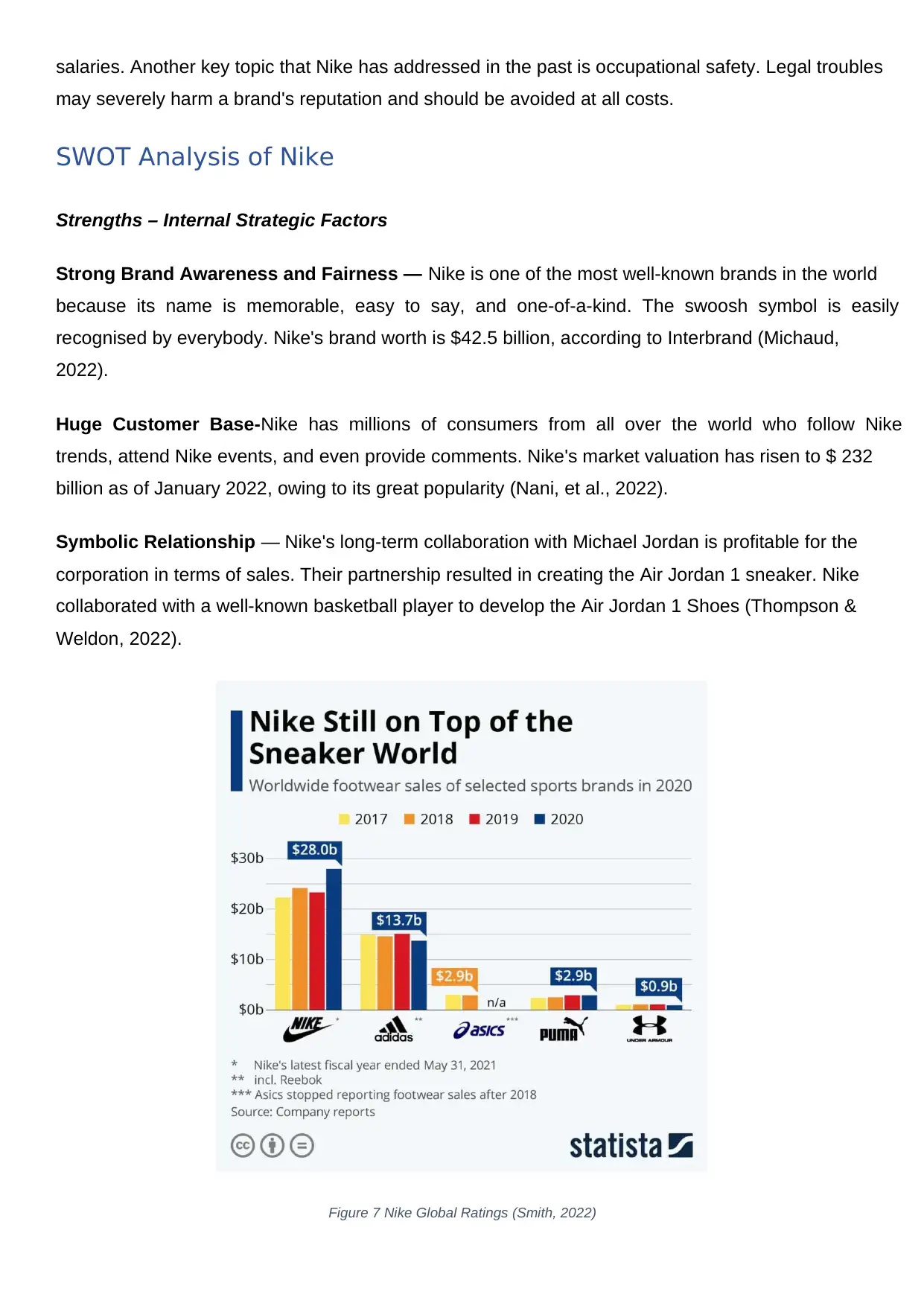
salaries. Another key topic that Nike has addressed in the past is occupational safety. Legal troubles
may severely harm a brand's reputation and should be avoided at all costs.
SWOT Analysis of Nike
Strengths – Internal Strategic Factors
Strong Brand Awareness and Fairness — Nike is one of the most well-known brands in the world
because its name is memorable, easy to say, and one-of-a-kind. The swoosh symbol is easily
recognised by everybody. Nike's brand worth is $42.5 billion, according to Interbrand (Michaud,
2022).
Huge Customer Base-Nike has millions of consumers from all over the world who follow Nike
trends, attend Nike events, and even provide comments. Nike's market valuation has risen to $ 232
billion as of January 2022, owing to its great popularity (Nani, et al., 2022).
Symbolic Relationship — Nike's long-term collaboration with Michael Jordan is profitable for the
corporation in terms of sales. Their partnership resulted in creating the Air Jordan 1 sneaker. Nike
collaborated with a well-known basketball player to develop the Air Jordan 1 Shoes (Thompson &
Weldon, 2022).
Figure 7 Nike Global Ratings (Smith, 2022)
may severely harm a brand's reputation and should be avoided at all costs.
SWOT Analysis of Nike
Strengths – Internal Strategic Factors
Strong Brand Awareness and Fairness — Nike is one of the most well-known brands in the world
because its name is memorable, easy to say, and one-of-a-kind. The swoosh symbol is easily
recognised by everybody. Nike's brand worth is $42.5 billion, according to Interbrand (Michaud,
2022).
Huge Customer Base-Nike has millions of consumers from all over the world who follow Nike
trends, attend Nike events, and even provide comments. Nike's market valuation has risen to $ 232
billion as of January 2022, owing to its great popularity (Nani, et al., 2022).
Symbolic Relationship — Nike's long-term collaboration with Michael Jordan is profitable for the
corporation in terms of sales. Their partnership resulted in creating the Air Jordan 1 sneaker. Nike
collaborated with a well-known basketball player to develop the Air Jordan 1 Shoes (Thompson &
Weldon, 2022).
Figure 7 Nike Global Ratings (Smith, 2022)
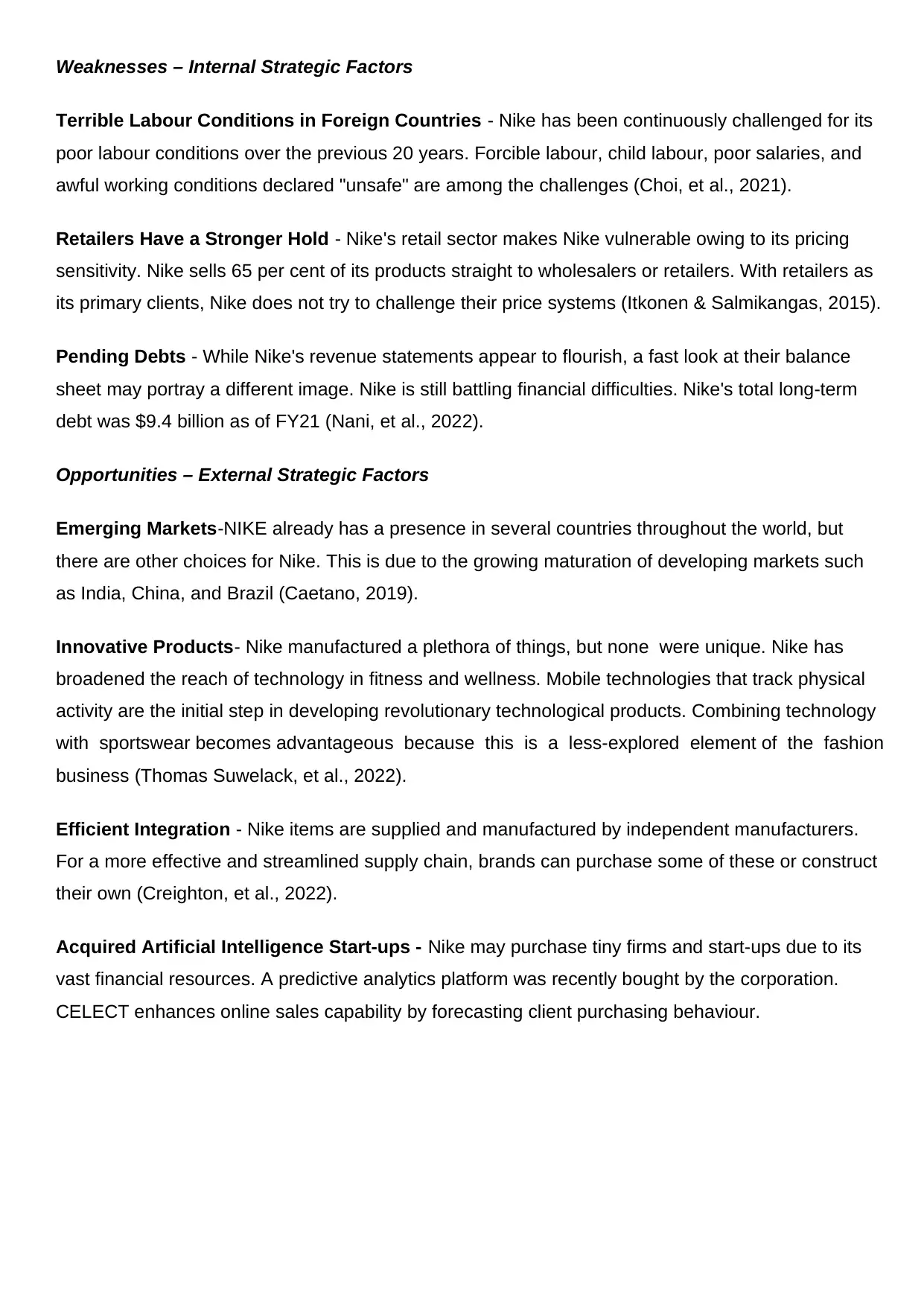
Weaknesses – Internal Strategic Factors
Terrible Labour Conditions in Foreign Countries - Nike has been continuously challenged for its
poor labour conditions over the previous 20 years. Forcible labour, child labour, poor salaries, and
awful working conditions declared "unsafe" are among the challenges (Choi, et al., 2021).
Retailers Have a Stronger Hold - Nike's retail sector makes Nike vulnerable owing to its pricing
sensitivity. Nike sells 65 per cent of its products straight to wholesalers or retailers. With retailers as
its primary clients, Nike does not try to challenge their price systems (Itkonen & Salmikangas, 2015).
Pending Debts - While Nike's revenue statements appear to flourish, a fast look at their balance
sheet may portray a different image. Nike is still battling financial difficulties. Nike's total long-term
debt was $9.4 billion as of FY21 (Nani, et al., 2022).
Opportunities – External Strategic Factors
Emerging Markets-NIKE already has a presence in several countries throughout the world, but
there are other choices for Nike. This is due to the growing maturation of developing markets such
as India, China, and Brazil (Caetano, 2019).
Innovative Products- Nike manufactured a plethora of things, but none were unique. Nike has
broadened the reach of technology in fitness and wellness. Mobile technologies that track physical
activity are the initial step in developing revolutionary technological products. Combining technology
with sportswear becomes advantageous because this is a less-explored element of the fashion
business (Thomas Suwelack, et al., 2022).
Efficient Integration - Nike items are supplied and manufactured by independent manufacturers.
For a more effective and streamlined supply chain, brands can purchase some of these or construct
their own (Creighton, et al., 2022).
Acquired Artificial Intelligence Start-ups - Nike may purchase tiny firms and start-ups due to its
vast financial resources. A predictive analytics platform was recently bought by the corporation.
CELECT enhances online sales capability by forecasting client purchasing behaviour.
Terrible Labour Conditions in Foreign Countries - Nike has been continuously challenged for its
poor labour conditions over the previous 20 years. Forcible labour, child labour, poor salaries, and
awful working conditions declared "unsafe" are among the challenges (Choi, et al., 2021).
Retailers Have a Stronger Hold - Nike's retail sector makes Nike vulnerable owing to its pricing
sensitivity. Nike sells 65 per cent of its products straight to wholesalers or retailers. With retailers as
its primary clients, Nike does not try to challenge their price systems (Itkonen & Salmikangas, 2015).
Pending Debts - While Nike's revenue statements appear to flourish, a fast look at their balance
sheet may portray a different image. Nike is still battling financial difficulties. Nike's total long-term
debt was $9.4 billion as of FY21 (Nani, et al., 2022).
Opportunities – External Strategic Factors
Emerging Markets-NIKE already has a presence in several countries throughout the world, but
there are other choices for Nike. This is due to the growing maturation of developing markets such
as India, China, and Brazil (Caetano, 2019).
Innovative Products- Nike manufactured a plethora of things, but none were unique. Nike has
broadened the reach of technology in fitness and wellness. Mobile technologies that track physical
activity are the initial step in developing revolutionary technological products. Combining technology
with sportswear becomes advantageous because this is a less-explored element of the fashion
business (Thomas Suwelack, et al., 2022).
Efficient Integration - Nike items are supplied and manufactured by independent manufacturers.
For a more effective and streamlined supply chain, brands can purchase some of these or construct
their own (Creighton, et al., 2022).
Acquired Artificial Intelligence Start-ups - Nike may purchase tiny firms and start-ups due to its
vast financial resources. A predictive analytics platform was recently bought by the corporation.
CELECT enhances online sales capability by forecasting client purchasing behaviour.
Secure Best Marks with AI Grader
Need help grading? Try our AI Grader for instant feedback on your assignments.
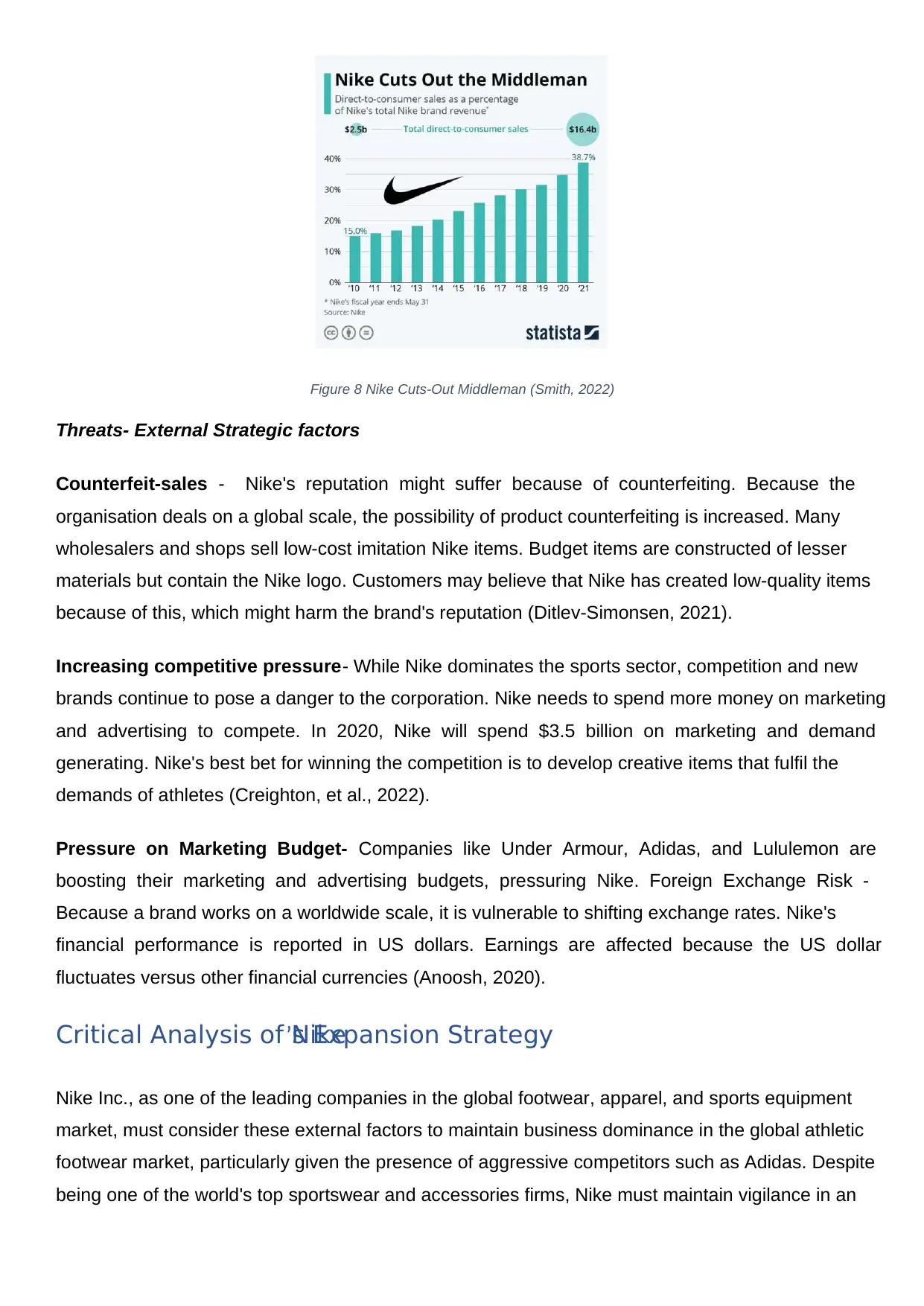
Figure 8 Nike Cuts-Out Middleman (Smith, 2022)
Threats- External Strategic factors
Counterfeit-sales - Nike's reputation might suffer because of counterfeiting. Because the
organisation deals on a global scale, the possibility of product counterfeiting is increased. Many
wholesalers and shops sell low-cost imitation Nike items. Budget items are constructed of lesser
materials but contain the Nike logo. Customers may believe that Nike has created low-quality items
because of this, which might harm the brand's reputation (Ditlev-Simonsen, 2021).
Increasing competitive pressure- While Nike dominates the sports sector, competition and new
brands continue to pose a danger to the corporation. Nike needs to spend more money on marketing
and advertising to compete. In 2020, Nike will spend $3.5 billion on marketing and demand
generating. Nike's best bet for winning the competition is to develop creative items that fulfil the
demands of athletes (Creighton, et al., 2022).
Pressure on Marketing Budget- Companies like Under Armour, Adidas, and Lululemon are
boosting their marketing and advertising budgets, pressuring Nike. Foreign Exchange Risk -
Because a brand works on a worldwide scale, it is vulnerable to shifting exchange rates. Nike's
financial performance is reported in US dollars. Earnings are affected because the US dollar
fluctuates versus other financial currencies (Anoosh, 2020).
Critical Analysis of Nike’s Expansion Strategy
Nike Inc., as one of the leading companies in the global footwear, apparel, and sports equipment
market, must consider these external factors to maintain business dominance in the global athletic
footwear market, particularly given the presence of aggressive competitors such as Adidas. Despite
being one of the world's top sportswear and accessories firms, Nike must maintain vigilance in an
Threats- External Strategic factors
Counterfeit-sales - Nike's reputation might suffer because of counterfeiting. Because the
organisation deals on a global scale, the possibility of product counterfeiting is increased. Many
wholesalers and shops sell low-cost imitation Nike items. Budget items are constructed of lesser
materials but contain the Nike logo. Customers may believe that Nike has created low-quality items
because of this, which might harm the brand's reputation (Ditlev-Simonsen, 2021).
Increasing competitive pressure- While Nike dominates the sports sector, competition and new
brands continue to pose a danger to the corporation. Nike needs to spend more money on marketing
and advertising to compete. In 2020, Nike will spend $3.5 billion on marketing and demand
generating. Nike's best bet for winning the competition is to develop creative items that fulfil the
demands of athletes (Creighton, et al., 2022).
Pressure on Marketing Budget- Companies like Under Armour, Adidas, and Lululemon are
boosting their marketing and advertising budgets, pressuring Nike. Foreign Exchange Risk -
Because a brand works on a worldwide scale, it is vulnerable to shifting exchange rates. Nike's
financial performance is reported in US dollars. Earnings are affected because the US dollar
fluctuates versus other financial currencies (Anoosh, 2020).
Critical Analysis of Nike’s Expansion Strategy
Nike Inc., as one of the leading companies in the global footwear, apparel, and sports equipment
market, must consider these external factors to maintain business dominance in the global athletic
footwear market, particularly given the presence of aggressive competitors such as Adidas. Despite
being one of the world's top sportswear and accessories firms, Nike must maintain vigilance in an
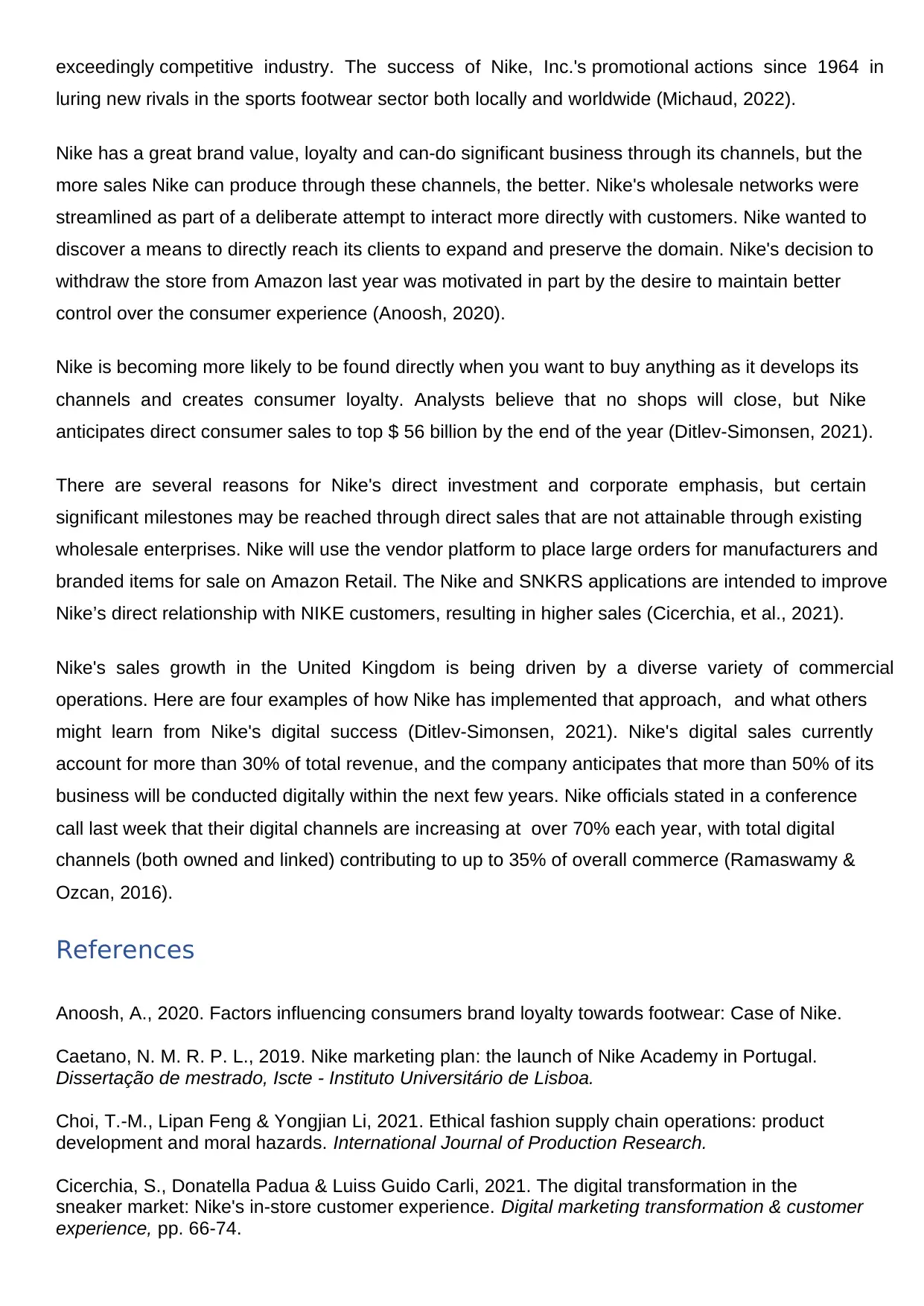
exceedingly competitive industry. The success of Nike, Inc.'s promotional actions since 1964 in
luring new rivals in the sports footwear sector both locally and worldwide (Michaud, 2022).
Nike has a great brand value, loyalty and can-do significant business through its channels, but the
more sales Nike can produce through these channels, the better. Nike's wholesale networks were
streamlined as part of a deliberate attempt to interact more directly with customers. Nike wanted to
discover a means to directly reach its clients to expand and preserve the domain. Nike's decision to
withdraw the store from Amazon last year was motivated in part by the desire to maintain better
control over the consumer experience (Anoosh, 2020).
Nike is becoming more likely to be found directly when you want to buy anything as it develops its
channels and creates consumer loyalty. Analysts believe that no shops will close, but Nike
anticipates direct consumer sales to top $ 56 billion by the end of the year (Ditlev-Simonsen, 2021).
There are several reasons for Nike's direct investment and corporate emphasis, but certain
significant milestones may be reached through direct sales that are not attainable through existing
wholesale enterprises. Nike will use the vendor platform to place large orders for manufacturers and
branded items for sale on Amazon Retail. The Nike and SNKRS applications are intended to improve
Nike’s direct relationship with NIKE customers, resulting in higher sales (Cicerchia, et al., 2021).
Nike's sales growth in the United Kingdom is being driven by a diverse variety of commercial
operations. Here are four examples of how Nike has implemented that approach, and what others
might learn from Nike's digital success (Ditlev-Simonsen, 2021). Nike's digital sales currently
account for more than 30% of total revenue, and the company anticipates that more than 50% of its
business will be conducted digitally within the next few years. Nike officials stated in a conference
call last week that their digital channels are increasing at over 70% each year, with total digital
channels (both owned and linked) contributing to up to 35% of overall commerce (Ramaswamy &
Ozcan, 2016).
References
Anoosh, A., 2020. Factors influencing consumers brand loyalty towards footwear: Case of Nike.
Caetano, N. M. R. P. L., 2019. Nike marketing plan: the launch of Nike Academy in Portugal.
Dissertação de mestrado, Iscte - Instituto Universitário de Lisboa.
Choi, T.-M., Lipan Feng & Yongjian Li, 2021. Ethical fashion supply chain operations: product
development and moral hazards. International Journal of Production Research.
Cicerchia, S., Donatella Padua & Luiss Guido Carli, 2021. The digital transformation in the
sneaker market: Nike's in-store customer experience. Digital marketing transformation & customer
experience, pp. 66-74.
luring new rivals in the sports footwear sector both locally and worldwide (Michaud, 2022).
Nike has a great brand value, loyalty and can-do significant business through its channels, but the
more sales Nike can produce through these channels, the better. Nike's wholesale networks were
streamlined as part of a deliberate attempt to interact more directly with customers. Nike wanted to
discover a means to directly reach its clients to expand and preserve the domain. Nike's decision to
withdraw the store from Amazon last year was motivated in part by the desire to maintain better
control over the consumer experience (Anoosh, 2020).
Nike is becoming more likely to be found directly when you want to buy anything as it develops its
channels and creates consumer loyalty. Analysts believe that no shops will close, but Nike
anticipates direct consumer sales to top $ 56 billion by the end of the year (Ditlev-Simonsen, 2021).
There are several reasons for Nike's direct investment and corporate emphasis, but certain
significant milestones may be reached through direct sales that are not attainable through existing
wholesale enterprises. Nike will use the vendor platform to place large orders for manufacturers and
branded items for sale on Amazon Retail. The Nike and SNKRS applications are intended to improve
Nike’s direct relationship with NIKE customers, resulting in higher sales (Cicerchia, et al., 2021).
Nike's sales growth in the United Kingdom is being driven by a diverse variety of commercial
operations. Here are four examples of how Nike has implemented that approach, and what others
might learn from Nike's digital success (Ditlev-Simonsen, 2021). Nike's digital sales currently
account for more than 30% of total revenue, and the company anticipates that more than 50% of its
business will be conducted digitally within the next few years. Nike officials stated in a conference
call last week that their digital channels are increasing at over 70% each year, with total digital
channels (both owned and linked) contributing to up to 35% of overall commerce (Ramaswamy &
Ozcan, 2016).
References
Anoosh, A., 2020. Factors influencing consumers brand loyalty towards footwear: Case of Nike.
Caetano, N. M. R. P. L., 2019. Nike marketing plan: the launch of Nike Academy in Portugal.
Dissertação de mestrado, Iscte - Instituto Universitário de Lisboa.
Choi, T.-M., Lipan Feng & Yongjian Li, 2021. Ethical fashion supply chain operations: product
development and moral hazards. International Journal of Production Research.
Cicerchia, S., Donatella Padua & Luiss Guido Carli, 2021. The digital transformation in the
sneaker market: Nike's in-store customer experience. Digital marketing transformation & customer
experience, pp. 66-74.
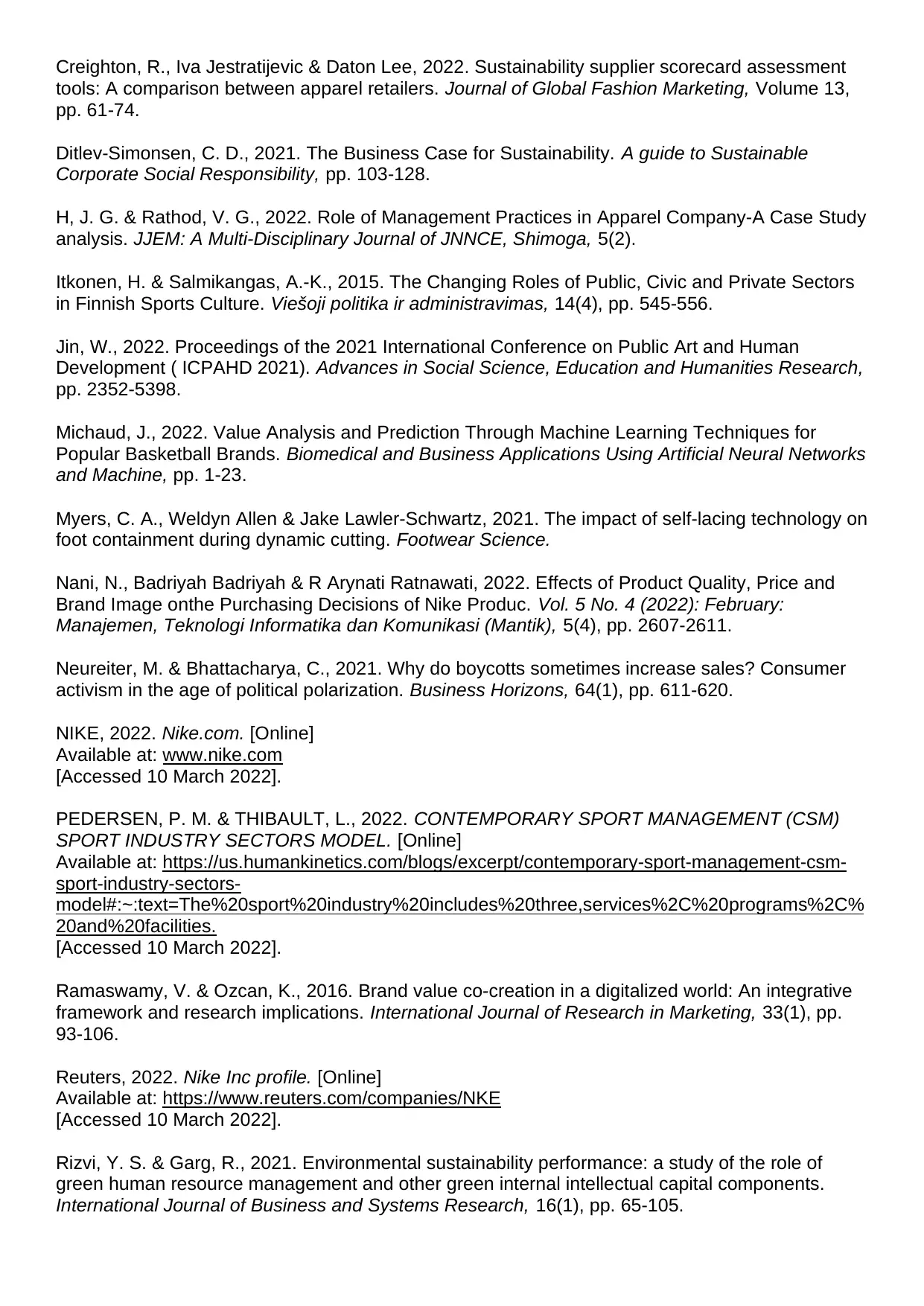
Creighton, R., Iva Jestratijevic & Daton Lee, 2022. Sustainability supplier scorecard assessment
tools: A comparison between apparel retailers. Journal of Global Fashion Marketing, Volume 13,
pp. 61-74.
Ditlev-Simonsen, C. D., 2021. The Business Case for Sustainability. A guide to Sustainable
Corporate Social Responsibility, pp. 103-128.
H, J. G. & Rathod, V. G., 2022. Role of Management Practices in Apparel Company-A Case Study
analysis. JJEM: A Multi-Disciplinary Journal of JNNCE, Shimoga, 5(2).
Itkonen, H. & Salmikangas, A.-K., 2015. The Changing Roles of Public, Civic and Private Sectors
in Finnish Sports Culture. Viešoji politika ir administravimas, 14(4), pp. 545-556.
Jin, W., 2022. Proceedings of the 2021 International Conference on Public Art and Human
Development ( ICPAHD 2021). Advances in Social Science, Education and Humanities Research,
pp. 2352-5398.
Michaud, J., 2022. Value Analysis and Prediction Through Machine Learning Techniques for
Popular Basketball Brands. Biomedical and Business Applications Using Artificial Neural Networks
and Machine, pp. 1-23.
Myers, C. A., Weldyn Allen & Jake Lawler-Schwartz, 2021. The impact of self-lacing technology on
foot containment during dynamic cutting. Footwear Science.
Nani, N., Badriyah Badriyah & R Arynati Ratnawati, 2022. Effects of Product Quality, Price and
Brand Image onthe Purchasing Decisions of Nike Produc. Vol. 5 No. 4 (2022): February:
Manajemen, Teknologi Informatika dan Komunikasi (Mantik), 5(4), pp. 2607-2611.
Neureiter, M. & Bhattacharya, C., 2021. Why do boycotts sometimes increase sales? Consumer
activism in the age of political polarization. Business Horizons, 64(1), pp. 611-620.
NIKE, 2022. Nike.com. [Online]
Available at: www.nike.com
[Accessed 10 March 2022].
PEDERSEN, P. M. & THIBAULT, L., 2022. CONTEMPORARY SPORT MANAGEMENT (CSM)
SPORT INDUSTRY SECTORS MODEL. [Online]
Available at: https://us.humankinetics.com/blogs/excerpt/contemporary-sport-management-csm-
sport-industry-sectors-
model#:~:text=The%20sport%20industry%20includes%20three,services%2C%20programs%2C%
20and%20facilities.
[Accessed 10 March 2022].
Ramaswamy, V. & Ozcan, K., 2016. Brand value co-creation in a digitalized world: An integrative
framework and research implications. International Journal of Research in Marketing, 33(1), pp.
93-106.
Reuters, 2022. Nike Inc profile. [Online]
Available at: https://www.reuters.com/companies/NKE
[Accessed 10 March 2022].
Rizvi, Y. S. & Garg, R., 2021. Environmental sustainability performance: a study of the role of
green human resource management and other green internal intellectual capital components.
International Journal of Business and Systems Research, 16(1), pp. 65-105.
tools: A comparison between apparel retailers. Journal of Global Fashion Marketing, Volume 13,
pp. 61-74.
Ditlev-Simonsen, C. D., 2021. The Business Case for Sustainability. A guide to Sustainable
Corporate Social Responsibility, pp. 103-128.
H, J. G. & Rathod, V. G., 2022. Role of Management Practices in Apparel Company-A Case Study
analysis. JJEM: A Multi-Disciplinary Journal of JNNCE, Shimoga, 5(2).
Itkonen, H. & Salmikangas, A.-K., 2015. The Changing Roles of Public, Civic and Private Sectors
in Finnish Sports Culture. Viešoji politika ir administravimas, 14(4), pp. 545-556.
Jin, W., 2022. Proceedings of the 2021 International Conference on Public Art and Human
Development ( ICPAHD 2021). Advances in Social Science, Education and Humanities Research,
pp. 2352-5398.
Michaud, J., 2022. Value Analysis and Prediction Through Machine Learning Techniques for
Popular Basketball Brands. Biomedical and Business Applications Using Artificial Neural Networks
and Machine, pp. 1-23.
Myers, C. A., Weldyn Allen & Jake Lawler-Schwartz, 2021. The impact of self-lacing technology on
foot containment during dynamic cutting. Footwear Science.
Nani, N., Badriyah Badriyah & R Arynati Ratnawati, 2022. Effects of Product Quality, Price and
Brand Image onthe Purchasing Decisions of Nike Produc. Vol. 5 No. 4 (2022): February:
Manajemen, Teknologi Informatika dan Komunikasi (Mantik), 5(4), pp. 2607-2611.
Neureiter, M. & Bhattacharya, C., 2021. Why do boycotts sometimes increase sales? Consumer
activism in the age of political polarization. Business Horizons, 64(1), pp. 611-620.
NIKE, 2022. Nike.com. [Online]
Available at: www.nike.com
[Accessed 10 March 2022].
PEDERSEN, P. M. & THIBAULT, L., 2022. CONTEMPORARY SPORT MANAGEMENT (CSM)
SPORT INDUSTRY SECTORS MODEL. [Online]
Available at: https://us.humankinetics.com/blogs/excerpt/contemporary-sport-management-csm-
sport-industry-sectors-
model#:~:text=The%20sport%20industry%20includes%20three,services%2C%20programs%2C%
20and%20facilities.
[Accessed 10 March 2022].
Ramaswamy, V. & Ozcan, K., 2016. Brand value co-creation in a digitalized world: An integrative
framework and research implications. International Journal of Research in Marketing, 33(1), pp.
93-106.
Reuters, 2022. Nike Inc profile. [Online]
Available at: https://www.reuters.com/companies/NKE
[Accessed 10 March 2022].
Rizvi, Y. S. & Garg, R., 2021. Environmental sustainability performance: a study of the role of
green human resource management and other green internal intellectual capital components.
International Journal of Business and Systems Research, 16(1), pp. 65-105.
Paraphrase This Document
Need a fresh take? Get an instant paraphrase of this document with our AI Paraphraser
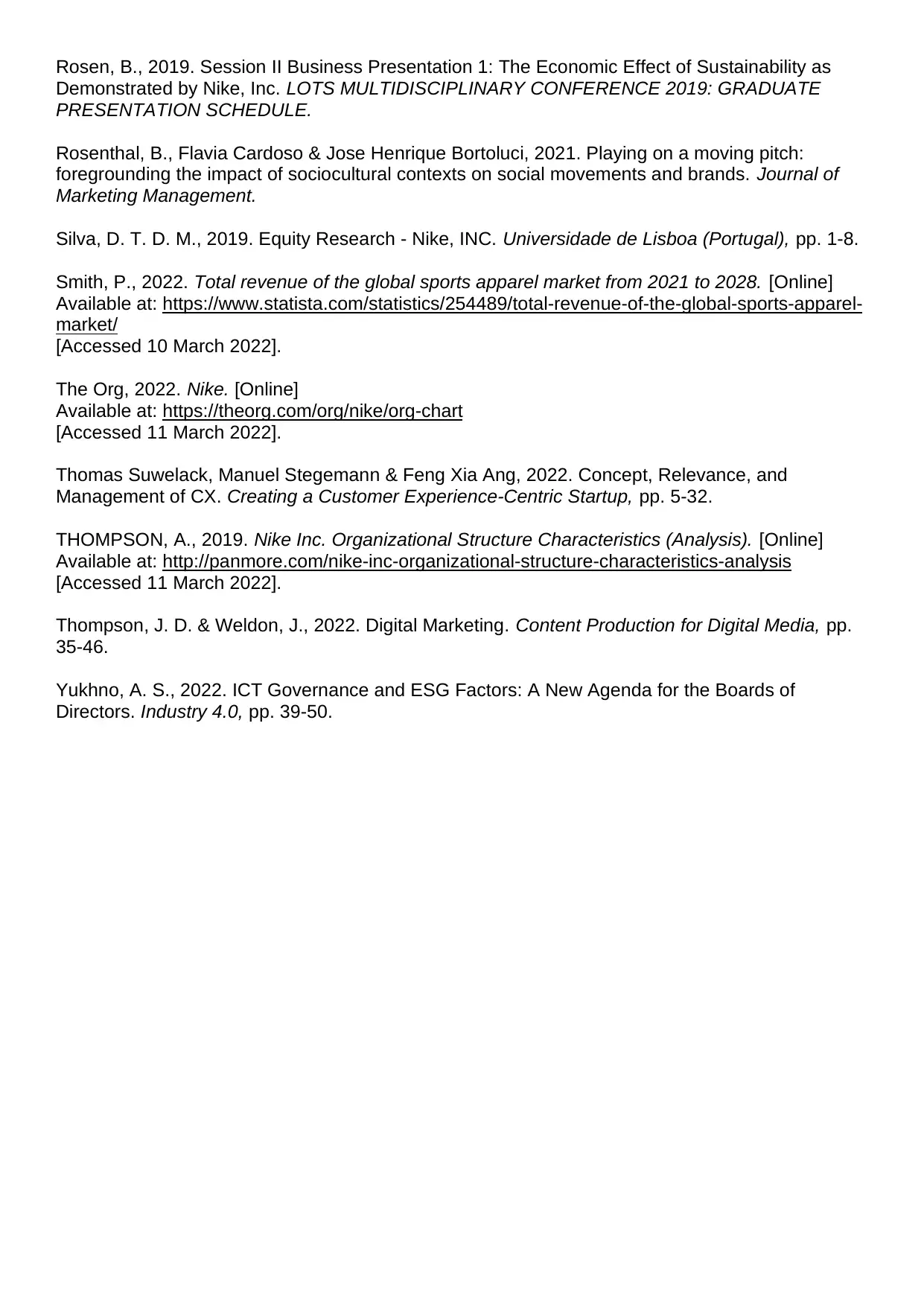
Rosen, B., 2019. Session II Business Presentation 1: The Economic Effect of Sustainability as
Demonstrated by Nike, Inc. LOTS MULTIDISCIPLINARY CONFERENCE 2019: GRADUATE
PRESENTATION SCHEDULE.
Rosenthal, B., Flavia Cardoso & Jose Henrique Bortoluci, 2021. Playing on a moving pitch:
foregrounding the impact of sociocultural contexts on social movements and brands. Journal of
Marketing Management.
Silva, D. T. D. M., 2019. Equity Research - Nike, INC. Universidade de Lisboa (Portugal), pp. 1-8.
Smith, P., 2022. Total revenue of the global sports apparel market from 2021 to 2028. [Online]
Available at: https://www.statista.com/statistics/254489/total-revenue-of-the-global-sports-apparel-
market/
[Accessed 10 March 2022].
The Org, 2022. Nike. [Online]
Available at: https://theorg.com/org/nike/org-chart
[Accessed 11 March 2022].
Thomas Suwelack, Manuel Stegemann & Feng Xia Ang, 2022. Concept, Relevance, and
Management of CX. Creating a Customer Experience-Centric Startup, pp. 5-32.
THOMPSON, A., 2019. Nike Inc. Organizational Structure Characteristics (Analysis). [Online]
Available at: http://panmore.com/nike-inc-organizational-structure-characteristics-analysis
[Accessed 11 March 2022].
Thompson, J. D. & Weldon, J., 2022. Digital Marketing. Content Production for Digital Media, pp.
35-46.
Yukhno, A. S., 2022. ICT Governance and ESG Factors: A New Agenda for the Boards of
Directors. Industry 4.0, pp. 39-50.
Demonstrated by Nike, Inc. LOTS MULTIDISCIPLINARY CONFERENCE 2019: GRADUATE
PRESENTATION SCHEDULE.
Rosenthal, B., Flavia Cardoso & Jose Henrique Bortoluci, 2021. Playing on a moving pitch:
foregrounding the impact of sociocultural contexts on social movements and brands. Journal of
Marketing Management.
Silva, D. T. D. M., 2019. Equity Research - Nike, INC. Universidade de Lisboa (Portugal), pp. 1-8.
Smith, P., 2022. Total revenue of the global sports apparel market from 2021 to 2028. [Online]
Available at: https://www.statista.com/statistics/254489/total-revenue-of-the-global-sports-apparel-
market/
[Accessed 10 March 2022].
The Org, 2022. Nike. [Online]
Available at: https://theorg.com/org/nike/org-chart
[Accessed 11 March 2022].
Thomas Suwelack, Manuel Stegemann & Feng Xia Ang, 2022. Concept, Relevance, and
Management of CX. Creating a Customer Experience-Centric Startup, pp. 5-32.
THOMPSON, A., 2019. Nike Inc. Organizational Structure Characteristics (Analysis). [Online]
Available at: http://panmore.com/nike-inc-organizational-structure-characteristics-analysis
[Accessed 11 March 2022].
Thompson, J. D. & Weldon, J., 2022. Digital Marketing. Content Production for Digital Media, pp.
35-46.
Yukhno, A. S., 2022. ICT Governance and ESG Factors: A New Agenda for the Boards of
Directors. Industry 4.0, pp. 39-50.
1 out of 20
Related Documents
Your All-in-One AI-Powered Toolkit for Academic Success.
+13062052269
info@desklib.com
Available 24*7 on WhatsApp / Email
![[object Object]](/_next/static/media/star-bottom.7253800d.svg)
Unlock your academic potential
© 2024 | Zucol Services PVT LTD | All rights reserved.



